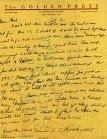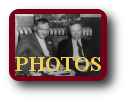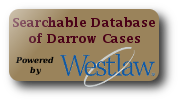Miscellaneous Topics
Clarence Darrow practiced law from 1879 until 1936 and he was a public figure for much of this time. Besides his many courtroom activities he participated in many debates, gave many speeches and wrote often about social, legal and political issues important to him. He was acquainted with many prominent and important people in public life. This section presents a wide variety of information and material about Clarence Darrow, his various interests as well as some of the people he knew or commented about.
|
Excerpt from an Economic Brief titled, "The Closed Shop and Union Security," submitted by the American Federation of Labor. The brief twice cites Clarence Darrow's article, "Why Men Fight for the Closed Shop."
Baxa v. United States (1964).
Excerpt from a petition for certiorari in which Clarence Darrow is quoted for his criticism of conspiracy laws.
The 1880 Census from Ashtabula County, Ohio shows an entry for Clarence Darrow and his wife Jessie. Darrow's occupation is listed as "lawyer" and his wife's occupation is listed as "keeping house." Darrow's entry is eighth from the bottom.
Marriage Certificate of Ammirus Darrow and Katherine Donahue (1898).
Ammirus Darrow, Clarence Darrow's father, remarried in 1898. From the Clarence Darrow Papers.
1900 Census: Chicago.
Clarence Darrow is number 16 on this page from 1900 Census for Chicago.
Strike in the Copper Mining District of Michigan.
"Letter from the Secretary of Labor, Transmitting in Response to a Senate Resolution of January 29, 1914, a Report in Regard to the Strike of Mine Workers in the Michigan Copper District which Began on July 23, 1913." Excerpt with references to Clarence Darrow's involvement in trying to end the strike.
Clarence Darrow listed in Illinois House of Representatives (1914).
Clarence Darrow is listed ninth in the left column. Page from the Blue Book of the State of Illinois.
Capital Punishment: Hearings Before the Subcommittee on Judiciary of the Committee on the District of Columbia (1926).
Hearings held from January 28 through February 13, 1926 on H.R. 349 and H.R. 4498. Clarence Darrow's statement begins on page 30 of this pdf document which is page 57 of this hearing. There are several critical references made about Clarence Darrow by other speakers. For example, on page 59 of the pdf is a short discussion of how much Darrow was paid for his defense of Leopold and Loeb. Most of page 61 consists of criticism about Darrow's views and an extended discussion about Darrow begins on page 80.
FBI File: 62-45014 on Clarence Seward Darrow (1936).
FBI file on Clarence Darrow. http://foia.fbi.gov/darrow/darrow1.pdf
Capital Punishment: Hearings Before Subcommittee No. 3 of the Committee of the Judiciary.
House of Representatives hearings on bills to suspend or abolish the death penalty held in March and May 1972. Several references are made to Clarence Darrow.
What Shall We Do for the Poor? by Paul Darrow.
Presentation by Clarence Darrow's son Paul to the Special Committee of the House of Representatives appointed to investigate the Interstate Migration of Destitute Citizens in August 1940. From the Papers of Clarence Darrow.
This version of Whitehead's piece appears in The Little Blue Book No. 1464, E. Haldeman-Julius, ed.
The Social Monster: A Paper on Communism and Anarchism by John Most (1890).
Johann (John) Most (1846 - 1906) was one of the most notorious anarchists in the United States. Born in Germany, he moved to London in 1878 where he became an anarchist and began publishing Die Freiheit. He published an article in 1881 praising the assassination of Tsar Alexander II of Russia for which he was arrested and sent to prison for 18 months. After getting out of prison in 1882 he emigrated to the United States and began living in Chicago. Most continued to publish Die Freiheit as well as other material and making speeches about anarchism while in the United States. His most notorious publication The Science of Revolutionary Warfare was published in 1885. In this work Most gave instructions for creating and using bombs. Most continued to publish Die Freiheit and books and pamphlets on anarchism until he died in Cincinnati, Ohio, in 1906. While not directly involved in any cases Clarence Darrow worked on, Most influenced several people Darrow came in contact with and sometimes defended. For example in 1904 Darrow and Edgar Lee Masters tried to keep John Turner, an avowed anarchist, from being deported back to Great Britain. Part of the evidence against Turner was a note found in his pocket about a mass-meeting at which speeches would be given by Turner and John Most and several other speakers. Most also influenced several of the Haymarket anarchists.
Biographical Sketch of Hon. John Peter Altgeld, Twentieth Governor of Illinois by Edward Osgood Brown (1905).
"Read before the Chicago Historical Society December 5, 1905 On the Occasion of the Presentation to the Society of Governor Altgeld's Portrait the Gift of Joseph S. Martin of Chicago." From the Internet Archive.
Trial of William Penn and How Voltaire Fooled Priest & King by Clarence Darrow (1922).
"Ten Cent Pocket Serious" pamphlet containing the Trial of William Penn followed by Clarence Darrow's How Voltaire Fooled Priest & King. Edited by E. Haldeman-Julius.
Short interviews with prominent citizens including Clarence Darrow on the issue of tax cheating. Published in The Public.
Clarence Darrow as Candidate (1902).
Short reference to Darrow as candidate for Illinois legislature. Published in The Public.
John Peter Altgeld's Funeral (1902).
Description of funeral services for John Peter Altgeld. Published in The Public.
Perils of Trade Unionism (1903).
Brief commentary about a speech Clarence Darrow gave about trade unionism to the Henry George Association in Chicago.
Article Praising Clarence Darrow as Illinois Legislature (1903).
Article praising Clarence Darrow for voting against a bill that would appropriate $5,000 for the widow of his mentor and former Governor of Illinois John Peter Altgeld.
In The Fight
Poem inscribed to Clarence S. Darrow by Dr. John Byers Wilson. From Tomorrow magazine (1907).
"Who Is This Man Darrow?" (1907).
Published in The Painter and Decorator by the Brotherhood of Painters, Decorators, and Paperhangers of America.
Clarence S. Darrow To the Prisoners in Chicago County Jail.
Description of Clarence Darrow's controversial address to Cook County prisoners in 1902. From volume 25 of The Railway Conductor (1908).
The Spoon River Anthology--The Storm-Center of the Latest Literary Controversy (1915).
Discussion of Edgar Lee Masters "The Spoon River Anthology" from Current Opinion (1915). The work made Masters' reputation and became one of the most widely read works of its time. Masters was Clarence Darrow's law partner for 8 years but they had a stormy relationship.
What Free Land Would Mean to Humanity: Clarence Darrow Discusses Economic Evils (1917).
Page two contains a description of dinner presentation by Clarence Darrow given at the Los Angeles Single Tax Club. Published in The Locomotive Firemen and Enginemen's Magazine.
George Burman Foster (1919).
Short article about George Burman Foster in The Biblical World. Foster was a well-known theologian and professor of philosophy of religion at the University of Chicago from 1905 until his death in 1918. Clarence Darrow and Foster were very good friends.
George Burman Foster.
Memorials to George Burman Foster in The University Record (1919). Clarence Darrow and Foster were best friends.
Darrow Debates Like a Wet Lamb (1926).
Debate between James Schermerhorn and Clarence Darrow about prohibition. Published in the Dearborn Independent Magazine by Henry Ford. Schermerhorn was the founder of the Detroit Times.
Clarence Darrow: The Big Minority Man by George G. Whitehead (1929).
Whitehead traveled with Darrow around the country to promote Darrow's debates on subjects ranging from prohibition to the question "Is Man a Machine?" and provides this fascinating account. Whitehead explains: "Mr. Darrow has been branded "The Big Minority Man" and the title fits him like an old slouch hat. In a debate he expects 80 percent of the audience to be against him, but he adds: "If the majority were with me I would think I was wrong.""(page 4).
Description of political speeches before a Republican crowd during the Presidential campaign. Story is in the center and is titled "Thurston Talks for McKinley." Published in The San Francisco Call.
Clarence Darrow's Sarcasm (1903).
Short reference to speech Clarence Darrow gave about Leo Tolstoy. From the Davis County Clipper.
“Pacifists Are Enemies of the Republic,” Says Clarence Darrow.
Newspaper article about a speech Clarence Darrow gave criticizing pacifists and supporting United States military involvement in World War I. Published in The Richmond Palladium And Sun-Telegram, November 13, 1917.
Schopenhauer's Son (1922).
Description of Clarence Darrow's pessimism and Darrow's short eulogy at the funeral of his friend George Burman Foster. Published in A Thousand and One Afternoons in Chicago by Ben Hecht, a newspaper column in the Chicago Daily News.
Clarence Darrow had to read McGuffey's Readers in grade school. Darrow recalled in his autobiography: "I know that I began at the primer and read over and over the McGuffey readers, up to the sixth, while at the district school. I have often wondered if there was such a man as Mr. McGuffey and what he looked like. To me his name suggested side-whiskers which, in Kinsman, meant distinction. I never could understand how he learned so much and how he could have been so good. I am sure that no set of books ever came from any press that was so packed with love and righteousness as were those readers. Their religious and ethical stories seem silly now, but at that time it never occurred to me that those tales were utterly impossible lies which average children should easily have seen through. McGuffey furnished us many choice and generally poetical instructions on conduct and morals. And the same sort were found in other books, also. . . . From what I see and hear of the present generation I should guess that Doctor McGuffey and his ilk lived in vain."
Our Penal Machinery and Its Victims, by John P. Altgeld (1886).
Judge Richards, a police judge in Ashtabula, gave me my first sane idea of crime and criminals. He gave me a book, Our Penal Machinery and Its Victims, by Judge John P. Altgeld, of Chicago, which was a revelation to me. This book and the author came to have a marked influence upon me and my future." - Clarence Darrow, The Story of My Life. From the Internet Archive.
Ad Brochure for The Story of My Life by Clarence S. Darrow.
Courtesy of the Special Collections Department, University of Iowa Libraries.
Great Speeches of Col. R. G. Ingersoll (1892).
Colonel Robert Green Ingersoll (1833 - 1899) was a Civil War veteran, noted orator, political leader, and forceful defender of agnosticism. Ingersoll greatly influenced Clarence Darrow. Because of his agnosticism Ingersoll was referred to by some of his critics as "Injuresoul."
A Message to Garcia and Thirteen Other Things: As Written by Fra Elbertus (1901).
Fra Elbertus was a pen name of Clarence Darrow's friend Elbert Hubbard. Hubbard reportedly wrote the inspirational essay "A Message to Garcia" in about an hour, and it became a sensational hit. It has reportedly sold over 40 million copies and has been translated into 37 languages. The essay is used by corporations and the military as an inspirational training guide for accomplishing organizational missions. From the Internet Archive.
Oratory: Its Requirements and Its Rewards by John P. Altgeld (1901).
Advice on oratory skills by Clarence Darrow's mentor John Peter Altgeld. From the Internet Archive.
The Cost of Something for Nothing by John Peter Altgeld (1904).
John Peter Altgeld was a mentor to Clarence Darrow. This was written just before Altgeld's death and contains an introduction by Clarence Darrow. From the Internet Archive.
Ad for Clarence Darrow's A Persian Pearl (1904).
Published in Bethink Yourselves!: A Letter on the Russian-Japanese War by Leo Tolstoy.
The New Star Chamber: And Other Essays By Edgar Lee Masters (1904).
Edgar Lee Masters was a law partner of Clarence Darrow from 1903 until 1911. A noted writer and poet, this book contains thirteen political essays some of which were previously published in the Chicago Chronicle. The essays helped earn Masters a reputation as a "radical." From the Internet Archive.
The Jungle by Upton Sinclair (1905).
Upton Sinclair was a Pulitzer Prize-winning author and social activist. He had given Clarence Darrow a copy of his book The Jungle and later wrote a letter to Darrow dated September 23, 1905 asking if he had read it and asking Darrow's legal opinion about whether it amounted to libel. Sinclair originally intended the book to expose the harsh and unfair working conditions endured by poor immigrants. But the general public was more shocked by the descriptions of unsanitary and dangerous food processing practices. The book was so influential that it led to the passage on the same day of the federal Meat Inspection Act of 1906 and the Pure Food and Drug Act of 1906 which in turn led to the establishment of the Food and Drug Administration. From the Internet Archive.
Memorandum of Agreement for publication of An Eye for an Eye (1905).
Clarence Darrow's agreement with the publisher Fox, Duffield & Co of New York.
The Finality of the Christian Religion by George Burman Foster (1906).
Publication of two lectures before the Harvard Summer School of Theology in 1902 and 1903. George Burman Foster was Professor of the Philosophy of Religion at the University of Chicago. Foster was a very prominent theologian, but he was also controversial because of his liberal interpretation of the Bible. George Burman Foster was one Clarence Darrow's best friends.
Advertisement for Works by Clarence Darrow described as Socialist Literature (1907).
From Socialism Inevitable: (Wilshire editorials) by Henry Gaylord Wilshire.
Review of Clarence Darrow's An Eye for an Eye (1908).
Short review of Clarence Darrow's book in The Bookman: A Review of Books and Life.
SILMA SILMASTA: Finnish translation of An Eye for An Eye (1908).
Cover, title page and first page from a Finnish translation of Clarence Darrow's book, An Eye for An Eye.
Land and Taxation: A Conversation Between David Dudley Field and Henry George (1911).
Excerpt from Our Land and Land Policy by Henry George in which George explains his single tax theory and how it would apply to land ownership. Clarence Darrow was an ardent supporter of George's single tax theory for many years.
The Flag Superstition.
Excerpt from Victor Berger's 1912 book Broadsides. Berger comments on a 1907 newspaper article about Clarence Darrow refusing to stand for the singing of the Star Spangled Banner at a hotel restaurant in Spokane, Washington.
Single Tax Exposed by Charles H. Shields (1912).
Subtitled, "an Inquiry Into the Operation of the Single Tax System as Proposed by Henry George in Progress and Poverty, the Book from which All Single Tax Advocates Draw Their Inspiration, Revealing the True and Real Meaning of Single Tax, which is Land Communism." Author was Secretary of the Oregon Equal Taxation League. From the Internet Archive.
My Life Out of Prison by Donald Lowrie (1915).
Excerpt discussing Clarence Darrow's stance against capital punishment. Donald Lowrie was convicted of burglary and sentenced to fifteen years in San Quentin State Prison. He served ten years and then wrote a book called My Life in Prison in which he argued for prison reform. He later wrote My Life Out of Prison. Lowrie was an influential prison reformer.
Spoon River Anthology by Edgar Lee Masters (1915).
Clarence Darrow and Edgar Lee Masters formed a law partnership in 1903 that lasted until 1911 but it was a stormy relationship. Besides being a lawyer, Masters was also a writer and poet. In 1915, Masters published Spoon River Anthology, a collection of poem epitaphs for over two-hundred citizens of fictional Spoon River, Illinois who have died. The work was very popular and established Master as a gifted writer. "It is perhaps not too much to say that the book created a sensation in literary circles. No book of poetry since Longfellow's popular volumes has had so wide a circulation, and none since Walt Whitman's Leaves of Grass has been more vigorously stimulating or shown more originally." Leonidas Warren Payne, History of American Literature. 356 (1919). From the Internet Archive.
Dunne: Judge, Mayor, Governor (1916).
Book about Edward F. Dunne. The book has several references to Clarence Darrow who was a friend of Dunne. From the Internet Archive.
The Pocket Cyclopedia of Temperance By Clarence True Wilson.
In 1910, Clarence True Wilson was appointed General Secretary of the Methodist Board of Temperance, Prohibition, and Public Morals (MBTP). He served in this position for twenty-five years. During Prohibition, the MBTP was an official agency of the northern Methodist Episcopal Church. According to one source, from 1925 to 1935 Clarence Darrow and Wilson held forty-six debates. During the course of their debates and the time they spent together Darrow and Wilson became very good friends. Published by Temperance Society of the M.E. Church, 1916.
The I.W.W.: Its History, Structure and Methods by Vincent St. John (1917).
Vincent St. John was a radical labor leader and one of the most influential early founders of the I.W.W. St. John and about 99 other I.W.W. member including Big Bill Haywood were convicted of violating the Espionage Act in 1918 for interfering with the war effort. Clarence Darrow represented St. John on several appeals before the Seventh Circuit Court of Appeals in 1918 and 1920.
The Cyclopedia of Temperance, Prohibition and Public Morals By Deets Pickett, Clarence True Wilson, and Ernest Dailey Smith (1917).
Clarence True Wilson, one of the authors, became good friends with Clarence Darrow and the two often debated each other over Prohibition. Published under the authority of the Board of Temperance, Prohibition, and Public Morals of the Methodist Episcopal Church. Clarence True Wilson was the General Secretary of this board.
Liquor Prohibition by Archibald Douglas Dabney (1920).
Collection of decisions interpreting various prohibition statutes.
Selected Articles on the Closed Shop (1922).
Affirmative and negative opinions of The Closed Shop, a book compiled by Lamar T. Beman. Several references are made to Clarence Darrow's views.
Kelly's Federal Prohibition Digest by Bernard Kelly (1922).
Effort to include all cases arising under the Prohibition Act as of 1922.
Book Review of Crime: Its Cause and Treatment (1923).
Book review of Clarence Darrow's book in The Catholic World.
To My Friend Abbie Scott Baker (1923).
Inscription Clarence Darrow wrote to Abbie Scott Baker in a copy of his book, Crime: Its Cause and Treatment. Abbie Scott Baker (1871-1944) was a leading member of the Congressional Union for Women's Suffrage and the National Women's Party. In 1917 she was arrested, convicted and served a prison sentence for participating in a suffrage protest in Washington, DC. Baker played a leading role in the passage of the 19th Amendment in 1920.
The Prohibition Mania: A Reply to Professor Irving Fisher and Others by Clarence Darrow & Victor S. Yarros
Clarence Darrow and Victor Yarros published this book in 1927 to refute the book Prohibition at Its Worst written by Professor Irving Fisher of Yale University who was a leading prohibitionist. Fisher was an economist, health campaigner, and eugenicist. He was one of the most prominent and celebrated economists in America during the early part of the twentieth century.
Let Freedom Ring by Arthur Garfield Hays (1928).
Title page and dedication page of Arthur Garfield Hay's book, Let Freedom Ring, which he dedicated to Clarence Darrow, Oswald Garrison Villard and Roger N. Baldwin.
The Red Network: A Who's Who and Handbook of Radicalism for Patriots by Elizabeth Dilling (1934).
Elizabeth Dilling Stokes was a staunch anti-communist and anti-war activist. The purpose of the book was to expose what she considered communist front activity in the United States. Clarence Darrow and many of his friends and acquaintances are listed in the book. Darrow is mentioned numerous times and his short bio is on page 275 of the book which is page 274 of this pdf.
Short bio of Hugh Reid Belknap who defeated Clarence Darrow in their race for Congress in the historic 1896 election. The official vote was 22,075 votes for the Republican Belknap and 21,485 votes for the Democrat Darrow.
Warranty Deed signed by Ammirus and Emily Darrow.
Warranty deed signed by Clarence Darrow's father and mother for a house in the "Connecticut Western Reserve" area in Ohio. Clarence Darrow Papers.
Letters from abolitionists Wendell Phillips & Rev. Parker Pillsbury.
This document includes an extract of a letter written by the abolitionist Wendell Phillips (1811 - 1884), along with a handwritten letter from Rev. Parker Pillsbury (1809 - 1898). Pillsbury was an American minister, abolitionist and supporter of women's rights. Part of the Clarence Darrow papers.
Crimes Against Criminals by Robert G. Ingersoll.
Address given before the New York State Bar Association in Albany, N.Y. January 21, 1890. Ingersoll was an outspoken atheist whom Clarence Darrow admired.
The Sunset Club: Shall the World's Fair Be Open on Sunday?; Women Suffrage; The Eight Hour Day (1891).
Clarence Darrow participated in discussion of these three topics at the Sunset Club in Chicago.
The Tyranny of Public Opinion (1893).
Discussion at the Sunset Club. Participants included Clarence Darrow.
Strikes and Injunctions - The Sunset Club 1894-95.
Clarence Darrow, Henry D. Lloyd and others participated in a discussion at the Sunset Club meeting about strikes and injunctions. The discussion was held at the Grand Pacific Hotel, Thursday October 25, 1894.
Clarence Darrow's Legal Opinion on Publishing a Controversial Paper (1900).
Doctor Denslow Lewis gave a controversial presentation before the American Medical Association (AMA) called "The Gynecologic Consideration of the Sexual Act." The AMA refused to publish the paper in the Journal of the American Medical Association. Denslow later asked Clarence Darrow for legal advice on whether a publisher would face obscenity charges for publishing it.
In Memoriam John Peter Altgeld, Born December 30, 1847, Died March 12, 1902.
Includes the Address of Clarence S. Darrow given at Altgeld's funeral on March 14, 1902.
Clarence Darrow in Who's Who in America (1903).
Who's Who in America was just four years old, having been founded in 1899.
Edward Everett Darrow.
Bio of Edward Everett Darrow (1846 - 1927) who was Clarence Darrow's oldest sibling. From the History of the Class of '70, Department of Literature, Science and the Arts published by the University of Michigan documenting the class of 1870.
The Democratic Convention by Charles Erskine Scott Wood.
Description of the 1904 Democratic Party Convention held in St. Louis. Contains a brief mention of a speech given by Clarence Darrow in which he supported the nomination of William Randolph Hearst for vice president (on page 5 of this pdf document). Published in The Pacific Monthly.
Graft in the Legal Profession by Clarence Darrow (1904).
Discussion held at a meeting of the Physician's Club of Chicago. Published in the Illinois Medical Journal.
Review of Clarence Darrow's Resist Not Evil (1905).
Published in The Open Court: Devoted to the Science of Religion, the Religion of Science, and the Extension of the Religious Parliament Idea.
Clarence Darrow in Who's Who in America (1906).
Who's Who in America began in 1899.
General Catalogue of Officers and Students: 1837-1911.
Brief listing from the University of Michigan showing Ammirus Darrow, an unrelated Darrow, Clarence Darrow, Edward Darrow, another unrelated Darrow and Mary Darrow, along with the years each attended the University. Ammirus was Clarence Darrow's father, Edward was his oldest sibling and Mary was his older sister.
Anecdote about Clarence Darrow.
Brief account of humorous quip by Clarence Darrow as a young lawyer. Published in After Dinner Stories by Famous Men.
Book Review of The Skeleton in the Closet (1915).
Clarence Darrow's essay "The Skeleton in the Closet" was first published in 1899 in his collection A Persian Pearl and Other Essays. This book review is from the Psychoanalytic Review published by the National Psychological Association for Psychoanalysis.
Henry Marison Byllesby.
Short bio of Henry Marison Byllesby (1859 - 1924) who was one of the most prominent electrical engineers of his time. Byllesby worked for Thomas Edison and George Westinghouse. He moved to St. Paul, Minnesota in 1891 to run an electrical company. He formed a power company in 1909 that later became Northern States Power in 1916. The company supplied power throughout Minnesota. He formed H.M. Byllesby & Co. a Chicago-based conglomerate that owned steamships, streetcars and utility companies across the United States. During World War I Byllesby was a prominent supporter of the Allies. Beginning in April 1917 he began working full-time as the Chairman of the Executive Committee of the Chicago Branch of the National Security League. This was a public service organization founded in 1914 to lobby for increased and improved preparation for America's defense against enemies at home and abroad. Byllesby was primarily responsible for the inauguration of a patriotic speaking campaign which opened in Minneapolis in September, 1917 with Samuel Gompers and Clarence Darrow as principal speakers. In 1917 Byllesby accepted a commission as a major and served in the Signal Corps and was later promoted to lieutenant-colonel. He also served in London as the purchasing agent for the American Expeditionary Force. Clarence Darrow knew Byllesby and served with him on the Chicago Branch of the National Security League. Darrow also conferred with Byllesby about investments in gas utilities.
The Peril of Racial Prejudice: A Statement to the Public (1922).
Statement by "citizens of Gentile birth and Christian faith" against Anti-Semitism. Signed by many prominent people including Clarence Darrow. Published in the American Jewish Year Book.
Dinner in Honor of Clarence Darrow to Commemorate his Seventieth Birthday (1927).
The following speakers will respond to toasts: DONALD RICHBERG, Darrow the Lawyer; SHIRLEY J. CASE, Darrow and Religion; WALTER WHITE, Darrow and the Negro; HARRY M. FISHER, Darrow the Advocate; ZONA GALE, Darrow and Literature; FAY-COOPER COLE, Darrow and Science; JOHN HAYNES HOLMES, Darrow the Humanitarian; TOASTMASTER: THOMAS V. SMITH.
Letter Sent by the American Civil Liberties Union (1932).
Letter republished in the The Red Network: A Who's Who and Handbook of Radicalism for Patriots by Elizabeth K. Dilling to expose radicals. Clarence Darrow is listed as a member of the National Committee and Arthur Garfield Hays is listed as Counsel. The caption states: "Facsimile of a letter typical of constant efforts of A.C.L.U. to influence legislation favored by radicals. Signed by John Haynes Holmes, acting Chairman while Harry F. Ward was in Russia. Note names of National Committee and Officers."
Letter from the Public Ownership League of America (1933).
Letterhead shows Clarence Darrow is listed as a member of the Executive Committee of the Public Ownership League of America. The letter was republished in the The Red Network: A Who's Who and Handbook of Radicalism for Patriots, by Elizabeth K. Dilling to expose radicals. Caption states: "Facsimile of significant letter sent out to "Members and Friends" by socialist Public Ownership League. Reveals close ties with Secretary Ickes. See Who's Who for signer of the letter, Carl D. Thompson, and other League leaders listed on letterhead.
Clarence Darrow bio in The Red Network: A Who's Who and Handbook of Radicalism for Patriots by Elizabeth K. Dilling. (1934).
Section from The Red Network: A Who's Who and Handbook of Radicalism for Patriots by Elizabeth K. Dilling. The section is titled, "Who Is Who In Radicalism?" and includes a short bio of Clarence Darrow showing affiliations that earned him inclusion in the Red Network.
Judge William H. Holly (1934).
Short bio of Judge Holly published in The Red Network: A "Who's Who" and Handbook of Radicalism for Patriots. Clarence Darrow and Judge Holly were very good friends.
In Memory of Mr. Clarence Darrow.
Funeral book for Clarence Darrow's funeral service held at Bond Chapel, University of Chicago on March 15, 1938. Courtesy of Special Collections Research Center, University of Chicago Library.
Address Delivered at the Funeral of Clarence S. Darrow by William H. Holly.
Typewritten draft of Judge Holly's eulogy with penciled in style edits.
Affirmative: George Burman Foster. Negative: Clarence Darrow.
The Biology Group of Chicago by Clarence Darrow.
This speech was given by Darrow to the Biology Group, of which he was a founding member.
"Realism in Literature and Art" by Clarence Darrow (1899).
Little Blue Book containing four writings by Clarence Darrow: Realism in Literature and Art, Robert Burns, George Burman Foster (Memorial Address January 12, 1919), Some Paragraphs Addressed to Socialists.
The State; Its Functions and Duties by Clarence Darrow & What Shall We Do With Our Criminals by Judge J.P. Altgeld (1891).
Presentations by Clarence Darrow and John Peter Altgeld at the Sunset Club in Chicago. Also contains information about the Sunset Club. Published in Echoes of the Sunset Club.
The Rights and Wrongs of Ireland by Clarence S. Darrow.
Address delivered at the Central Music Hall, Chicago on November 23, 1895, the anniversary of the execution of the "Manchester Martyrs" (William O'Mera Allen, Michael Larkin, and Michael O'Brien) who were members of the Irish Republican Brotherhood hanged in Salford, England on November 23, 1867. They were executed for killing a policeman during a prison escape.
A Persian Pearl and Other Essays by Clarence S. Darrow (1899).
Clarence Darrow's first book. The table of contents is as follows: (1) A Persian Pearl-9; (2) Walt Whitman-43; (3) Robert Burns-77; (4) Realism in Literature and Art-107; (5) The Skeleton in the Closet-139.
"The Skeleton in the Closet" by Clarence Darrow (1899).
Short story written by Clarence Darrow in 1899.
Crime and Criminals: An Address Delivered to the Prisoners in the Chicago County Jail.
1902 address in which Darrow gives his views about the causes of crime that are so radical that "[s]ome of my good friends have insisted that while my theories are true, I should not have given them to the inmates of a jail." Printed in 1919.
The Doctrine of Assumed Risk by Clarence Darrow (1902).
Part of critical commentary called "Easy Lessons in Law" written by Clarence Darrow and published in Hearst's Chicago Evening American in 1902. Darrow's story involves Tony Salvador, an Italian immigrant, who finds work as on a railroad but who lost a leg after being run over by a train. Tony tries to win compensation in court but the judge ruled that he assumed the risk of working in a dangerous area. This typewritten draft is from the Special Collections Research Center, University of Chicago Library.
Little Louis Epstine by Clarence S. Darrow (1903).
In December 1903 Darrow published this short fiction story in the magazine The Pilgrim. Louis is nine years old, poor and Jewish. He is missing one hand due to an accident when he was much younger. One day in the winter he stays out in the cold selling newspapers because he wants to earn enough money to buy a small Christmas present for his mother. This leads to frostbite and he has to have his only hand amputated. Darrow wrote it as a sad reality check on the traditional cheery Christmas tale. This typewritten draft is from the Special Collections Research Center, University of Chicago Library.
Farmington by Clarence Darrow (1904).
Clarence Darrow's autobiographical novel.
An Eye for an Eye by Clarence Darrow (1905).
Fictional story of a man sentenced to death for killing his wife.
Literary Style by Clarence Darrow (1905).
Darrow offers advice about writing. Published in Tomorrow Magazine.
Speech of Clarence S. Darrow.
Speech about prohibition given at the Opera House in Youngstown Ohio Sunday, May 2, 1909. Among the things Darrow told the audience: "Now, I have practiced law a good many years, and have helped to pick out a good many juries. Anybody can try a case, but you must have a good jury. If I had to defend a criminal case I would never let a prohibitionist on the jury, not if I could help it. A lawyer who would let one of them on a jury, if he could avoid it would be guilty of malpractice."
Liberty vs. Prohibition (1909).
Address by Clarence Darrow at a public meeting held in New Bedford, Mass., on December 4, 1909. The introduction to the address states that, "This city, with Worcester and others, changed from 'dry' to 'wet' by a large majority in the election held a fortnight later."
The Darrow-Lewis Debate on "The Theory of Non-resistance" (1910).
For: Clarence Darrow. Against: Arthur M. Lewis. Garrick Theatre, Chicago.
Marx versus Tolstoy: A Debate (1911).
Clarence S. Darrow and Arthur M. Lewis.
Henry George by Clarence Darrow.
Address at the Henry George Anniversary Dinner of the Single Tax Club, Chicago, September 19th, 1913.
The Cost of War by Clarence Darrow (1914).
Short article published in 1914 by the International Socialist Review in which Clarence Darrow explained his view that the destruction of private property caused by the war would benefit the working class. Darrow believed that the rebuilding that would be needed would help employ people and raise the wages of those who helped rebuild the destroyed property.
How One Painter Worked for Peace by Clarence Darrow (1914).
One page article about the Russian painter Vasily Vasilyevich Vereshchagin. This is a reprint from Darrow's "Realism in Literature and Art". Published in The Metal Polisher, Buffer, and Plater journal by the Metal Polishers, Buffers, Platers & Helpers International Union.
Baccalaureate Address Delivered by Clarence S. Darrow to the Law Graduates of Valparaiso University (1914).
Clarence Darrow's address demonstrates his social philosophy, views about the professional life of lawyers and about the American legal system. Given in Darrow's typical blunt style.
The Chrysalis: Prison Epics by Inmates of State and Federal Institutions (1916).
This excerpt includes a contribution "[w]ritten [e]xpressly for The Chrysalis by the Hon. Clarence Darrow, famous Western Lawyer and author, entitled "Punishment."
The Land Belongs to the People by Clarence Darrow (1916).
Short article in which Darrow argues against private property. Published in Everyman.
Darrow-Foster Debate: "Is Life Worth Living?" (1917).
Affirmative: Professor George Burman Foster; Negative: Clarence S. Darrow.
The War (1917).
Address by Clarence Darrow about World War I. Darrow forcefully explains why America was justified in entering the war. The address was given under the Auspices of the National Security League.
The War in Europe (1918).
Lecture on World War I given by Clarence Darrow before the Chicago Society of Rationalism.
Voltaire by Clarence S. Darrow.
Lecture given in the Court Theater on February 3, 1918.
Response of Clarence Darrow to Birthday Greetings, April 18, 1918.
Birthday celebration held at the Auditorium Hotel, Chicago on Clarence Darrow's 61st birthday.
Darrow-Kennedy Debate: "Are Internationalism and the League of Nations Practical and Desirable Schemes for Ending War?" (1918).
Affirmative: Professor John C. Kennedy. Negative: Clarence Darrow. Garrick Theater, Chicago.
Remarks of Clarence Darrow at the Memorial Services to George Burman Foster and at the Funeral of John P. Altgeld.
The memorial service for George Burman Foster was held on January 12, 1919. The funeral for John P. Altgeld was held on March 14, 1902.
The Hold Up Man by Clarence Darrow (1919).
Short article by Darrow about crime and societal norms.
Darrow-Kennedy Debate: "Will Socialism Save the World?" (1919).
Affirmative: Professor John C. Kennedy, Alderman 27th Ward. Negative: Clarence Darrow. Garrick Theater, Chicago.
Darrow-Kennedy Debate: "Is the Human Race Permanently Progressing Toward a Better Civilization?" (1919).
Darrow takes the negative side of the issue. Professor John C. Kennedy was at one time a professor at the University of Chicago. At the time of the debate, he was an alderman from Chicago's 27th ward.
War Prisoners (1919).
Speech by Clarence Darrow supporting America's involvement in World War I. Darrow's support of the war effort was in sharp contrast to most of his socialist friends. Among his controversial remarks he said, "I have no doubt but what constitutional rights were violated over and over again during the war, and since--and before. In the main, I, as one individual, was willing to see constitutional rights violated during the war." Garrick Theater, Chicago.
Pessimism (1920).
Clarence Darrow lecture under the auspices of the Rationalist Educational Society.
Darrow-Starr Debate: Is Life Worth Living?
Yes: Frederick Starr, Anthropologist, University of Chicago No: Clarence S. Darrow. GARRICK THEATRE Sunday Afternoon, March 28th, 1920.
Darrow-Starr Debate: "Is Civilization a Failure?" (1920).
Affirmative: Clarence Darrow. Negative: Professor Frederick Starr. Garrick Theater, Chicago.
Walt Whitman by Clarence Darrow (1924).
Transcript of presentation given by Clarence Darrow at a dinner honoring Walt Whitman.
Debate on Prohibition (1924).
Debate on the topic "Resolved: That the United States Continue the Policy of Prohibition as Defined in the Eighteenth Amendment" between Clarence Darrow and his friend Dr. John Haynes Holmes, pastor of the Community Church in New York. During the debate Darrow told the audience: "Take out of this world the men who have drank, down through the past, and you would take away all the poetry and literature and practically all the works of genius that the world has produced. What kind of poem do you suppose you would get out of a glass of ice-water?"
Dry-Law Debate (1927).
Clarence Darrow vs. Wayne B. Wheeler held in Carnegie Hall, New York City on April 23, 1927. Wayne B. Wheeler was the general counsel for the Anti-Saloon League of America.
Can the Individual Control His Conduct? (1928).
Clarence Darrow and Thomas Vernor Smith debate "Is man a 'free agent' or is he the slave of his biological equipment?"
The Most Cruel Nation on Earth by Clarence Darrow (1930)..
Criticism of the criminal sentencing policies in the United States. Published in The Island Lantern at the U.S. Penitentiary, McNeil Island, Washington.
Verbatim Report of Clarence Darrow's Testimonial on George A. Schilling (1933).
Testimonial dinner given by the Biology Group. George A. Shilling was a labor movement leader and Secretary of the Illinois State Board of Labor Commissioners. Darrow met Shilling in 1888 at a single tax club meeting and they became lifelong friends. In his autobiography Darrow wrote, "Mr. Shilling was about the first man I met when I came to Chicago, and he has been a close friend ever since." Clarence Darrow, The Story of My Life.
"Attorney for the Defense" by Clarence Darrow.
In 1936 at age 79, Clarence Darrow wrote "Attorney for the Defense" that was published in the May edition of Esquire. Darrow described how to pick a jury and the reasons for seating or rejecting prospective jurors based on ethnicity, class and religious beliefs.
Photos
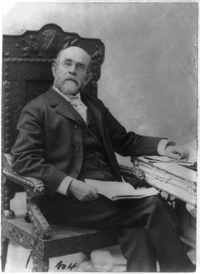 Henry George. Clarence Darrow was an ardent supporter of Henry George's Single Tax theory for many years. In 1888 Darrow spoke after Henry George at a "Free Trade Convention" in Chicago. Darrow apparently spoke very well and even Henry George congratulated him. Library of Congress Prints and Photographs Division, LC-USZ62-79139. |
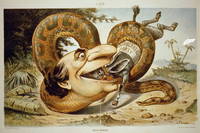 Swallowed! Political cartoon showing python with head of William Jennings Bryan, as Populist Party, swallowing the Democratic Party donkey. Illus. in: Puck, v. 47 (1900 July 11). Library of Congress Prints and Photographs Division, LC-USZC4-1473. |
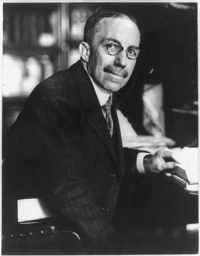 Wayne Bidwell Wheeler. Wayne Wheeler (1869 - 1927) was the General counsel for the Anti-Saloon League. Clarence Darrow debated Wheeler about prohibition. Called the "Dry-Law Debate" it took place on April 23 in Carnegie Hall, New York City. Library of Congress Prints and Photographs Division, LC-USZ62-72968. |
 Anti-Saloon League at Washington, D.C. Library of Congress Prints and Photographs Division, DIGITAL ID:6a34368. |
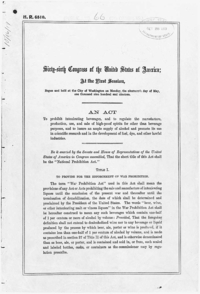 National Prohibition Act. Also known as the Volstead Act. Clarence Darrow hated prohibition and for years he publicly criticized it in his writings and in speeches and debates. |
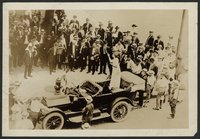 Elsie Hill speaking at a street meeting during Prohibition Party convention in St. Paul, Minnesota. The Prohibition Party convention endorsed a plank advocating a suffrage amendment. Women of Protest: Photographs from the Records of the National Woman's Party, Manuscript Division, Library of Congress, Washington, D.C. |
 Allegheny College, Meadville, Pennsylvania c. 1909. Clarence Darrow attended Allegheny in 1872 and stayed for one year. His father had graduated from this college. Darrow wrote in his 1932 autobiography: "I spent one year at Allegheny College. I came back a better ball player for my higher education. I learned to despise the study of Latin and Greek, although I never told my father so." Library of Congress Prints and Photographs Division, pan 6a09137. |
 Allegheny College, Meadville, Pennsylvania c. 1907. In 1872 Clarence Darrow attended Allegheny College a Methodist institution. Darrow spent one year at Allegheny. His father had graduated from this same college. Library of Congress Prints and Photographs Division, pan 6a09269. |
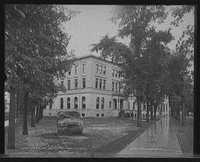 Law Building, University of Michigan, Ann Arbor [between 1890 and 1901]. In 1877, at the insistence of his father, 20-year old Clarence Darrow attended the University of Michigan (Ann Arbor) Law department. He stayed for one year and later studied law on his own while working in a law office in Youngstown, Ohio. Library of Congress Prints and Photographs Division, LC-D4-11921. |
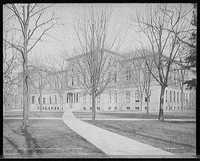 Law Building, University of Michigan c. 1905. Clarence Darrow attended the law school at the University of Michigan in 1877 and stayed one year. Library of Congress Prints and Photographs Division, LC-D4-18268. |
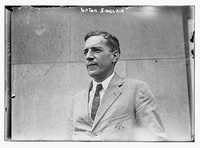 Upton Sinclair. In September 1905 Clarence Darrow was approached by Upton Sinclair, who wanted legal advice about whether his book The Jungle, which he was preparing to publish, would subject him to libel charges. The book, about the extremely unsanitary and dangerous conditions and corruption in Chicago's meat slaughtering and processing plants, was published in 1906. Sinclair had originally intended the book to expose the harsh and unfair working conditions endured by the poor, especially immigrants. But the general public found the exposure of the unsanitary and dangerous food handling practices even more sensational and disgusting. The book was so influential it is credited with leading to passage of the federal Meat Inspection Act and the Pure Food and Drug Act of 1906, which led to the establishment of the Food and Drug Administration. Library of Congress Prints and Photographs Division, LC-DIG-ggbain-06185. |
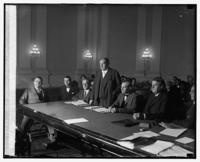 Clarence Darrow Testifying in Hearing to Abolish Capital Punishment in the District of Columbia. In February 1926 Darrow testified during hearings held by the Subcommittee on the Judiciary of the House Committee on the District of Columbia to abolish capital punishment in the District of Columbia. Darrow told those present: "If a man can think of how often he has been a murderer himself, he would have some sympathy with other fellows who are legally killed; and, of course, we are all murderers at heart—that is, I never killed anybody, but I often read an obituary notice with great satisfaction [laughter], which means that I approve of it alright, and everybody else does the same. Good people get a great kick out of hanging; they always approve of that death. And there you are. It is in all of us; it is only a question of terms and conditions under which it comes out. If we realize it, we are probably a little sorry for the other fellows, whom we know perfectly well were governed by circumstances just as well as we are." Library of Congress Prints and Photographs Division, LC-DIG-npcc-15481. |
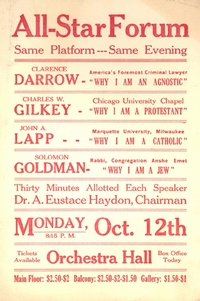 All-Star Forum. Clarence Darrow, Charles W. Gilkey, John A. Lapp, Solomon Goldman, Haydon, A. Eustace. Courtesy of the Special Collections Department, University of Iowa Libraries. |
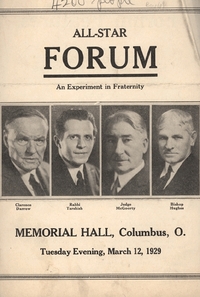 All-Star Forum: An Experiment in Fraternity. Ad for lecture featuring Clarence Darrow, Rabbi Jacob Tarshish, Judge John P. McGoorty, and Bishop Edwin H. Hughes. Courtesy of the Special Collections Department, University of Iowa Libraries. |
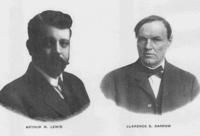 Arthur M. Lewis and Clarence S. Darrow. Clarence Darrow and Arthur M. Lewis debated the topic "The Theory of Non-resistance" on February 6, 1910. Lewis was a popular socialist lecturer and writer. |
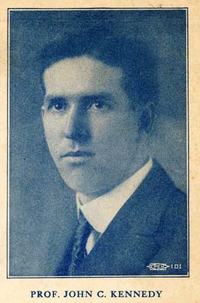 Professor John C. Kennedy. Photo from cover of "Will Socialism Save the World?" Affirmative: Professor John C. Kennedy. Negative: Mr. Clarence S. Darrow, at the Garrick Theatre, Chicago, Illinois, January 26, 1919. |
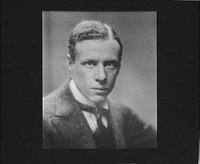 Sinclair Lewis. Sinclair Lewis (1885 - 1951) was an American novelist and playwright. In 1930, he became the first American to be awarded the Nobel Prize in Literature. Lewis wrote a letter to his friend Clarence Darrow dated April 7, 1926 in which he said "This noon I talked it all over with Burris Jenkins and we agreed that the lady who tried to assassinate Mussolini had a good idea but she would have contributed much more to human progress if she had taken a shot at you instead." Photo is from a negative taken March 7, 1914. Library of Congress Prints and Photographs Division, LC-G4085-0410. |
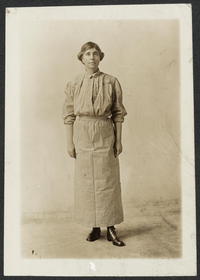 Abby Scott Baker in prison dress, 1917. Abby Scott Baker served as an officer of the National Women's Party (NWP) and personally lobbied numerous prominent politicians. The NWP was considered the militant wing of the suffrage movement. In 1918 she became the political chairman of the NWP. Baker was arrested for picketing and sentenced to 60 days in a workhouse in September 1917. Clarence Darrow inscribed several of his books to her. Women of Protest: Photographs from the Records of the National Woman's Party, Manuscript Division, Library of Congress, Washington, D.C. |
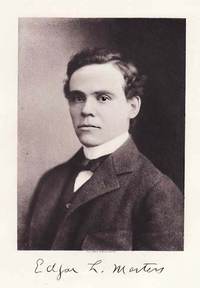 Edgar Lee Masters. In 1897 Clarence Darrow and Edgar Lee Masters met when Masters, a poet and attorney, sent a case to Darrow's firm. In 1898, Darrow offered Masters a position in his firm but Masters turned the offer down because Darrow "was not in good odor in Chicago." Herbert K. Russell, Edgar Lee Masters: A Biography (2001). In 1903, Masters reconsidered Darrow's offer and they formed a law partnership. Shortly thereafter Francis Wilson joined the firm. Darrow and Masters had a stormy relationship, but the partnership lasted until 1911. Photo from The Bench and Bar of Illinois: Historical and Reminiscent by John McAuley Palmer (1899). |
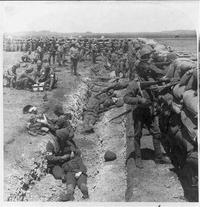 Royal Munster Fusiliers Fighting from Behind the Redoubt at Honey Nest Kloof, South Africa. February 16, 1900. Medics treating wounded in back of redoubt during Boer War. Clarence Darrow and his mentor John Peter Altgeld publicly supported the Boer's against the British. Recalling Altgeld's feelings about the war Darrow wrote in The Story of My Life: "One new great emotion came into his life toward the end. This was the Boer War. All his friends were for the Boers. Although I had never been an enemy of England, I felt that this war waged by them was without excuse. Then, too, it presented the picture of a great nation trampling a small one into the earth. Both Altgeld and I held a large number of meetings for the purpose of awakening the sympathy of our country for the Boers." Library of Congress Prints and Photographs Division, LC-USZ62-42613. |
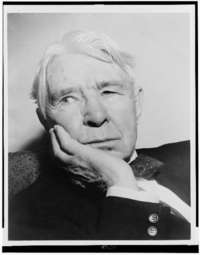 Carl Sandburg. Carl Sandburg (1878 - 1967) was a poet, writer and editor. He won two Pulitzer Prizes, one for a biography of Abraham Lincoln and another for poetry. Sandburg once said of his friend Clarence Darrow "He rates for me as being somewhat to Chicago what Diogenes was to Athens." Library of Congress, LC-USZ62-115064. |
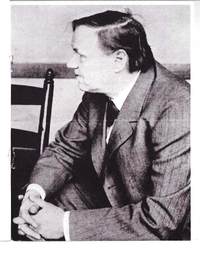 Clarence S. Darrow'. |
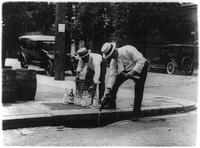 Pouring Whiskey into a Sewer. Destroying contraband alcohol during Prohibition. Library of Congress Prints and Photographs Division, LC-USZ62-12142. |
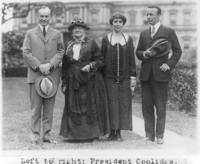 President Coolidge, Mother Jones, Mrs. Coolidge, and Theodore Roosevelt, Jr. Mary Harris "Mother" Jones was a very prominent labor supporter. Clarence Darrow and Mother Jones were good friends. Library of Congress Prints and Photographs Division, LC-USZ62-111392. |
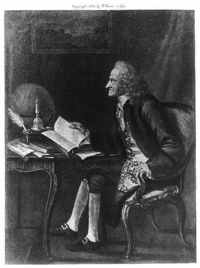 Francois Marie Arouet de Voltaire, 1694-1778. Clarence Darrow greatly admired Voltaire. Library of Congress Prints and Photographs Division, LC-USZ62-72043. Created c. 1900. |
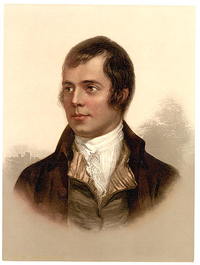 Robert Burns. Robert Burns (1759 - 1796) is Scotland's greatest poet. In his 1899 book A Persian Pearl and other Essays Darrow wrote a chapter about Burns which he ended with: "Dear Robert Burns, to place one flower upon your grave, or add one garland to your fame is a privilege indeed. A noble man you were, knighted not by King or Queen, but titled by the Infinite Maker of us all. You loved the world; you loved all life; you were gentle, kind and true. Your works, your words, your deeds, will live and shine to teach the brotherhood of man, the kinship of all breathing things, and make the world a brighter, gentler, kindlier place because you lived and loved and sung." Library of Congress Prints and Photographs Division, LC-DIG-ppmsc-07528. |
 Anti-War Meeting, Union Square, New York City on August 8, 1914. Unlike many on the political left, Clarence Darrow strongly supported the entry of the United States into World War 1. Library of Congress Prints and Photographs Division, LC-USZ62-21718. |
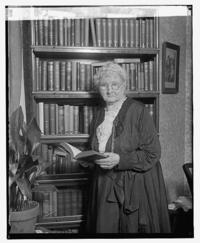 Mother Jones. Mary Harris "Mother" Jones was born in Cork, Ireland on May 1, 1830. She became a prominent American labor supporter known for her fiery attitude, a community organizer, a member of the Industrial Workers of the World, and a Socialist. A U.S. Attorney once called her "the most dangerous woman in America." She died on November 30, 1930, seven months after she turned 100 years old. Clarence Darrow was a friend of Mother Jones and he wrote an introduction for the Autobiography of Mother Jones by Mary Harris Jones & Mary Field Parton. Library of Congress Prints and Photographs Division, LC-DIG-npcc-17427. |
 United States Government War Exhibition, September 2-15, 1918, Chicago, Ill. Clarence Darrow was a very vocal supporter of the Allied effort to defeat Germany in World War I. Library of Congress Prints and Photographs Division. |
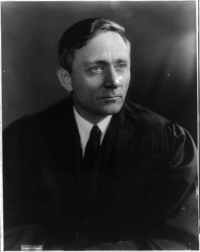 William Orville Douglas. Justice Douglas was appointed by President Franklin Roosevelt and served from April 17, 1939 until November 12, 1975. Douglas wrote the forward to the book Attorney for the Damned: Clarence Darrow in the Courtroom published in 1957. Library of Congress Prints and Photographs Division, LC-USZ62-44543. |
 Andrew J. Volstead c. 1921. Andrew John Volstead (1860 - 1947) represented Minnesota in the United States House of Representatives from 1903 - 1923, as a member of the Republican Party. Volstead collaborated with Wayne Wheeler of the anti-Saloon League, to draft a national prohibition bill. Volstead sponsored the bill and worked to ensure its passage so it is referred to as the Volstead Act. Library of Congress Prints and Photographs Division, LC-DIG-npcc-21190. |
 The Battle, U.S. Government War Exposition, Chicago, September 3, 1918. Library of Congress Prints and Photographs Division, LC-USZ62-112051. |
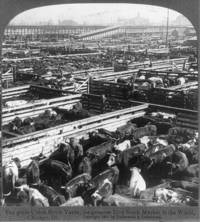 The Great Union Stock Yards, Chicago c. 1903. Upton Sinclair's 1906 book The Jungle was based on observations he made at Chicago's Union Stockyards in 1904. In September 1905 Sinclair wrote a letter to Clarence Darrow asking for legal advice about whether his book would subject him to libel charges. The stockyards were in operation from 1865 to 1971. Library of Congress Prints and Photographs Division, LC-USZ62-51793. |
 Panoramic Picture Illustrating the Beef Industry, 1900. In September 1905 Darrow was approached by Upton Sinclair, who wanted legal advice about whether his book The Jungle, which he was preparing to publish, would subject him to libel charges. The book, about the extremely unsanitary and dangerous conditions and prevalent corruption in Chicago's meat slaughtering and processing plants, was published in 1906. Sinclair had originally intended the book to expose the harsh and unfair working conditions endured by the poor, especially immigrants. But the general public found the exposure of the unsanitary and dangerous food handling practices even more sensational and disgusting. The book was so influential it is credited with leading to passage of the federal Meat Inspection Act and the Pure Food and Drug Act of 1906, which led to the establishment of the Food and Drug Administration. Library of Congress Prints and Photographs Division, LC-USZ62-52728. |
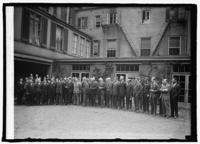 Senator Stanley & Clarence Darrow with Washington Lawyers at the Cosmos Club, Washington, D.C. Augustus Owsley Stanley, a Representative and a Senator from Kentucky from May 19, 1919 until March 3, 1925. Library of Congress Prints and Photographs Division, LC-DIG-npcc-26882. |
 Senator Stanley & Clarence Darrow. Augustus Owsley Stanley (1867 - 1958) served in various positions including Governor of Kentucky and as a Representative and a Senator from Kentucky. Library of Congress Prints and Photographs Division, LC-DIG-npcc-26879. |
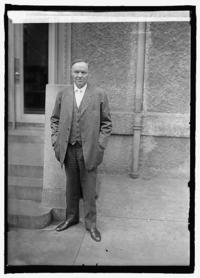 Clarence Darrow at the Cosmos Club, Washington, D.C. "The Cosmos Club is a private social club, incorporated in Washington, D.C. in 1878 by men distinguished in science, literature and the arts. In June, 1988 the Club voted to welcome women as members." Library of Congress Prints and Photographs Division, LC-DIG-npcc-26881. |
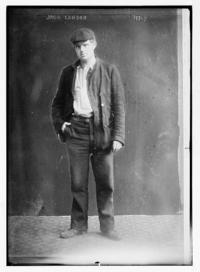 Jack London. Upton Sinclair and a group of prominent socialists, including Jack London and Clarence Darrow, formed the Intercollegiate Socialist Society (ISS) in New York in 1905. Other founding members included James Graham Phelps Stokes, Charlotte Perkins Gilman, William English Walling, Thomas Wentworth Higginson, Leonard D. Abbott, B. 0. Flowers, and Oscar Lovell Triggs. The ISS was organized to promote the study and advocacy of socialism among college students and faculty members. The ISS changed its name to the League for Industrial Democracy in 1921. Library of Congress Prints and Photographs Division, LC-DIG-ggbain-00675. |
 Caricatures of Clarence Darrow. Published in his autobiography, The Story of My Life. |
 Dr. Clarence True Wilson. Clarence True Wilson (1872 - 1939) was appointed General Secretary of the Methodist Board of Temperance, Prohibition, and Public Morals (MBTP) in 1910. He served in this position for twenty-five years. During Prohibition, the MBTP was an official agency of the northern Methodist Episcopal Church. According to one source, from 1925 to 1935 Clarence Darrow and Wilson held 46 debates on prohibition. In the summer of 1931, Darrow and Wilson traveled to Toronto Canada to conduct a joint study of Ontario's government liquor control. During the course of their debates and the time they spent together Darrow and Wilson became very good friends. Library of Congress Prints and Photographs Division, LC-DIG-npcc-17419. |
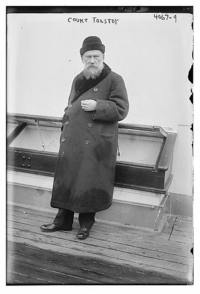 Count Leo Tolstoy. Clarence Darrow was a great admirer of Tolstoy. Library of Congress Prints and Photographs Division, LC-DIG-ggbain-23331. |
 Leo Tolstoy c. 1897. Count Leo Tolstoy (1828 - 1910) was a Russian novelist and philosopher. Clarence Darrow came to be deeply influenced by the non-resistance philosophy of Leo Tolstoy. In 1902, Darrow published Resist Not Evil. He explained in the preface, "It is not claimed that the following pages contain any new ideas. They were inspired by the writings of Tolstoy, who was the first, and in fact the only, author of my acquaintance who every seemed to me to place the doctrine of non-resistance upon a substantial basis." When World War I started Darrow quickly changed his mind about non-resistance and he came to believe it was too utopian. Library of Congress Prints and Photographs Division, LC-USZ62-67518. |
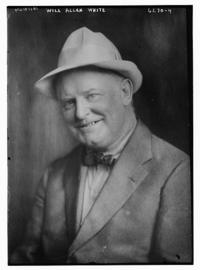 William Allen White. William Allen White (1868 - 1944) was a very well-known newspaper editor and author. In 1895 White purchased The Emporia Gazette reportedly for $3,000 although some sources put the price at $5,000. The newspaper is still operated by the White family. White gained national prominence and political influence in the Republican Party with an editorial titled "What's the Matter With Kansas?" published on August 16, 1896. White wrote the editorial in haste while still agitated over an impromptu debate he had on a street corner with some local populists while he was waiting to board a train. The debate involved the presidential campaign between William McKinley and William Jennings Bryan. The editorial sharply criticized populist political policies for ruining the economy of Kansas. White dashed to his office and wrote the editorial. Mark Hanna, Republican national chairman, had the editorial reprinted in papers across the country. White became a confidant of President Theodore Roosevelt and in 1912 helped form the Progressive Party. The William Allen White School of Journalism and Mass Communications at the University of Kansas is named in his honor. Clarence Darrow and William Allen White were friends and corresponded by letters. Library of Congress Prints and Photographs Division, LC-DIG-ggbain-37609. |
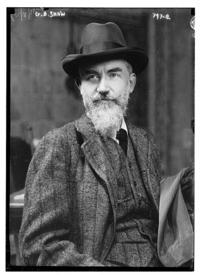 George Bernard Shaw. George Bernard Shaw (1856 - 1950) was a famous Irish playwright. Clarence and Ruby Darrow traveled to Europe in 1903 for their honeymoon. They met Shaw in London and Darrow and Shaw got along well. Shaw later wrote that he instinctively liked Darrow "perhaps because he is a genuine noble savage--with that cheekbone he wants only a few feathers and a streak of ochre to be a perfect Mohican . . . ." Letter, George Bernard Shaw to Henry S. Salt, August 19, 1903. Library of Congress Prints and Photographs Division, LC-DIG-ggbain-03906. |
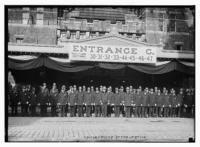 Chicago Police. Clarence Darrow was generally very critical of the police in the United States. He wrote in his autobiography: "It is true that of the people arrested a much larger proportion are convicted in England than here, but what does this prove" Scotland Yard seldom takes any one into custody except on thorough investigation and convincing proof. This is not brought about by the third degree. No officer could remain on the police force in that country if he resorted to the shameless beating and brutality that everywhere prevails in America. When the English police take one into custody he is pretty sure to be guilty. In America it is not uncommon to arrest five or ten, or even fifty, and subject them all to all sorts of indignities in order to find the one man. In the meantime, if the matter is at all sensational, the police are spurred on by continuous startling stories broadcast by the press, and the whole populace gleefully and righteously joins in the man hunt." Photo taken at the 1912 Republican National Convention held at the Chicago Coliseum, Chicago, Illinois, June 18-22. Library of Congress Prints and Photographs Division, LC-DIG-ggbain-10560. |
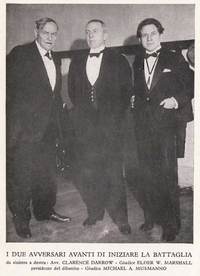 Does Man Live Again? Cover from pamphlet containing an Italian translation of a debate titled "Does Man Live Again?" between Clarence Darrow and Michael A. Musmanno held at Carnegie Music Hall, Pittsburgh, Pennsylvania, December 12, 1932. Michael Angelo Musmanno (1897 - 1968) was a United States Naval officer and a Justice of the Pennsylvania Supreme Court and politician in the Pennsylvania legislature. Musmanno rose to the rank of Rear Admiral in the United States Navy and at the end of World War II served on the International Military Tribunal at the Nuremberg Trials. He also led the investigation to determine if Adolf Hitler died at the end of the war. He later served as an appellate attorney for Sacco and Vanzetti. Musmanno was also a staunch anti-communist. In 1961 he was a witness for the prosecution in the trial of Adolf Eichmann. |
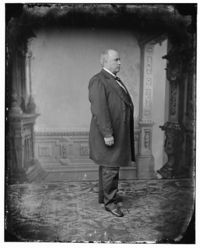 Robert G. Ingersoll [between 1865 and 1880]. Colonel Robert Green Ingersoll (1833 - 1899) was a Civil War veteran, noted orator, political leader, and forceful defender of agnosticism. Clarence Darrow wrote in his autobiography: "When I was beginning to absorb and to act, all the young lawyers and speakers were aping Ingersoll's style. No one ever really spoke as he did; one could analyze Ingersoll's speeches if not imitate them; every sentence was rhythmical and in prose; as much so as the best of Keats or Robert Burns, or Housman in poetry. There was never so much as a word awry. There were the exact number of feet to fit the prose measure, and the subject. Evidently most of his speeches were accurately prepared; and, above all, he had something to say. I heard him twice, and with every one in the audience I was entranced. Along with the other aspiring lawyers I tried to adopt his style, and I think I succeeded fairly well, at that time, but it was not Ingersoll. Others tried, too, but most of them failed, so far as I knew. I have found a few who mastered his form of expression, but they lacked what Ingersoll never lacked and that was something worth saying. I took myself in hand. I made up my mind that I could not be Ingersoll and had no right to try, and did not want to try; that the best I could do was to be myself." Library of Congress Prints and Photographs Division, LC-DIG-cwpbh-04126. |
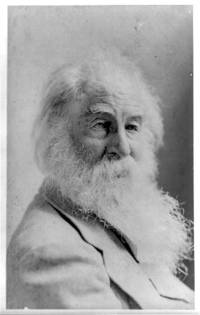 Walt Whitman. Clarence Darrow admired Walt Whitman. In 1899 Darrow published his first book, A Persian Pearl and Other Essays which included an essay about Walt Whitman. Created/Published: between 1880 and 1892. Library of Congress, LC-USZ62-92198. |
 John Philip Sousa at Chautauqua c. 1925. Chautauqua was an adult education movement in the United States. The lecture series was very popular in the late 19th and early 20th centuries. Clarence Darrow began giving speeches at Chautauqua meetings starting around 1914. Darrow was a good draw and he would come to rely on Chautauqua lecture fees in the years to come. Library of Congress Prints and Photographs Division, LC-USZ62-133887. |
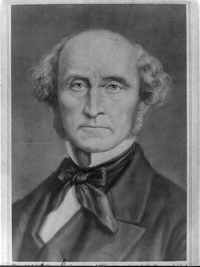 John Stuart Mill. John Stuart Mill (1806 - 1873) was a British philosopher, economist, and political theorist. He is considered one of the most influential English-speaking philosophers of the nineteenth century. Clarence Darrow wrote in his 1904 semi-autobiographical novel Farmington: "I remember that at a very early age I was told again and again that John Stuart Mill began studying Greek when he was only three years old. I thought then, as I do today, that he must have had a cruel father, and that this unnatural parent not only made miserable the life of his little boy, but of thousands of other boys whose fathers could see no reason why their sons should be outdone by John Stuart Mill. I have no doubt that my good father thought that all his children ought to be able to do anything that was ever accomplished by John Stuart Mill; and so he did his part, and more, to make us try.\r\n\r\nBut, after all, I feel to-day just as I did long years ago, when with reluctant ear and rebellious heart I heard of the great achievements of John Stuart Mill. I look back to those early years, and still regret the beautiful play-spells that were broken and the many fond childish schemes for pleasure that were shattered because John Stuart Mill began studying Greek when three years old." Library of Congress Prints and Photographs Division, LC-USZ62-76491. |
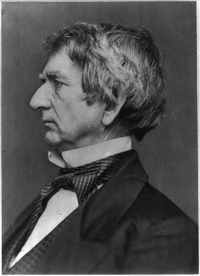 William Henry Seward. William Henry Seward, Sr. (1801 - 1872) served as Governor of New York, United States Senator and Secretary of State under Abraham Lincoln. Seward, a Republican, was an outspoken opponent of slavery. He was very nearly assassinated the same night Abraham Lincoln was assassinated. Clarence Darrow's abolitionist parents greatly admired Seward and gave Clarence the middle name of Seward in his honor. Library of Congress Prints and Photographs Division, LC-USZ62-21907. |
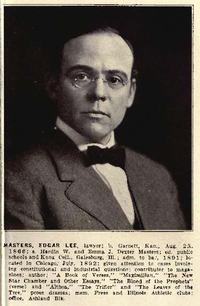 Edgar Lee Masters. Edgar Lee Masters was an attorney and poet. In 1903 Masters joined Darrow to form a law partnership. Darrow and Masters had a stormy relationship, but the partnership lasted until 1911. In 1915, Masters published Spoon River Anthology, a collection of poems that established Master as a gifted writer. |
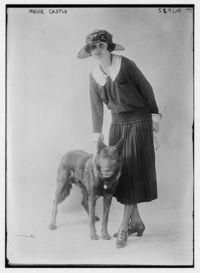 Irene Castle. Irene Castle (1893 - 1969) was born Irene Foote in New Rochelle, New York. She and her first husband Vernon were a famous ballroom dancing team in the early 20th century. Vernon was killed in a plane crash in Texas while training American pilots for WWI. In November 1923, she married her third husband, Major Frederic McLaughlin the owner of the Chicago Blackhawks hockey team. Irene designed the famous Blackhawk hockey jersey with unique black, red, and white stripes and with the head of Chief Blackhawk on the logo. In 1929, she wrote a letter to Clarence Darrow as Irene Castle McLaughlin asking his help with a "Dog Exemption Bill." She was an outspoken advocate for animal rights and in 1931 had an Illinois farmer arrested for abusing his hogs. He later sued her for false arrest and malicious prosecution. Library of Congress Prints and Photographs Division. LC-DIG-ggbain-34024. |
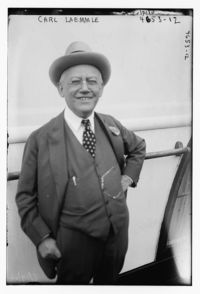 Carl Laemmle. Carl Laemmle was a founder and president of Universal Pictures Corporation. In 1931 Clarence Darrow narrated and appeared in a film about evolution titled Mystery of Life that was distributed by Carl Laemmle. The film also featured Howard Madison Parshley, a professor at Smith College from 1917 until 1952, who was for many years chairman of its Zoology Department. Smith wrote the screenplay and during the movie explained scientific and biological concepts and Darrow would then add his own remarks. The movie was popular and favorably reviewed although some found it controversial. Library of Congress Prints and Photographs Division, LC-DIG-ggbain-27254. |
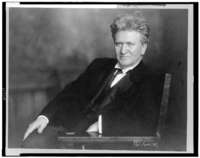 Robert La Follette c 1911. Robert Marion La Follette, Sr. (1855 - 1925) nicknamed "Fighting Bob" La Follette was the 20th Governor of Wisconsin serving from 1901 to 1906 and Republican Senator from Wisconsin from 1906 to 1925). In 1924 he ran for President of the United States as the nominee of his own Progressive Party in 1924 during which he carried Wisconsin and got 17 percent of the national popular vote. He gained a reputation as a strong proponent of Progressivism with a strong stance against railroad trusts, political bosses, World War I, and the League of Nations. La Follette was friends with Clarence Darrow and they corresponded by letter. Library of Congress, LC-USZ62-106669. |
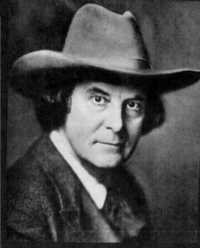 Elbert Hubbard. In 1899, Clarence Darrow published his first book A Persian Pearl and Other Essays. It was published by The Roycroft Shop founded by Elbert Hubbard in East Aurora, New York as part of the Arts and Crafts Movement. Darrow and Hubbard were friends and exchanged letters. |
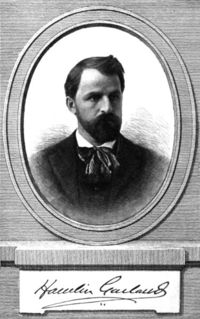 Hamlin Garland. Hamlin Hannibal Garland (1860 - 1940) was a novelist, short-story writer, poet, essayist, and memoirist. He also lectured widely on American literature. Garland was friends with Clarence Darrow and they corresponded by letter. http://en.wikipedia.org /wiki/File:Hamlin _Garland_-_Project _Gutenberg_etext_ 20695.jpg |
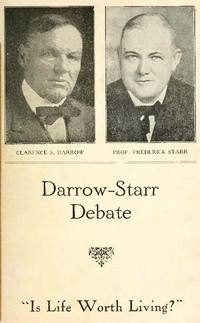 Is Life Worth Living? On March 28, 1920 Clarence Darrow debated Professor Starr on the question "Is Life Worth Living?" in Chicago. Darrow argued in the negative. In his introduction the chairman stated that the debate has to do with "the great philosophy of pessimism, of which Mr. Clarence Darrow is the greatest living exponent." Cover from published pamphlet of the debate. |
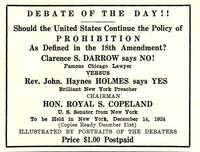 Debate of the Day! Advertisement for debate between the Rev. John Haynes Holmes and Clarence Darrow. |
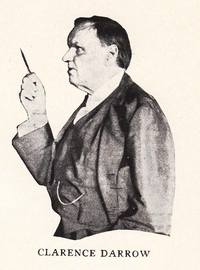 Clarence Darrow. From cover of pamphlet containing debate about capital punishment between Clarence Darrow and Judge Alfred J. Talley. |
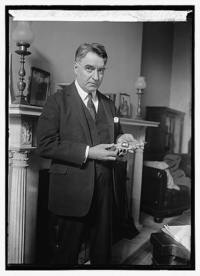 Senator Royal S. Copeland. Royal Samuel Copeland (1868 - 1938) was a house surgeon in the University of Michigan Hospital from 1889 - 1890, a medical practitioner in Bay City, Michigan from 1890 - 1895, and a professor in the medical school of the University of Michigan from 1895 - 1908. He was also a politician and served as mayor of Ann Arbor from 1901 - 1903 and he represented New York in the United States Senate from 1923 until 1938. In March 1931 Clarence Darrow participated as defense counsel in a mock trial of Benedict Arnold. The prosecutor was played by James M. Beck (1861 - 1936) a highly regarded lawyer and politician from Philadelphia, Pennsylvania. Beck served as U.S. Solicitor General and U.S. Representative from Pennsylvania. A group of eminent men and women were enlisted as a "radio jury" and listened to the trial over the radio and rendered a guilty verdict by telegraph. Senator Royal Copeland was a member of the radio jury. The trial was produced by the National Dairy Products Corporation and was broadcast over numerous radio stations on March 22nd and 29th. Library of Congress Prints and Photographs Division, LC-DIG-npcc-25273. |
 Arthur Brisbane c. 1906. Arthur Brisbane was an American newspaper editor, the first syndicated newspaper writer, and one of most influential editorial writers in the history of newspapers in the United States. In September 1905 he wrote a letter to Clarence Darrow thanking Darrow for offering to defend him against a libel suit. Although the case looked like it would be dropped he told Darrow, "I cannot think of anybody whom I should better have to address a jury, than yourself." When he wrote the letter he was editor of Hearst's New York Evening Journal. He was a very important and influential executive in the Hearst news and media empire. Library of Congress, LC-USZ62-106247. Brisbane Letter to Darrow |
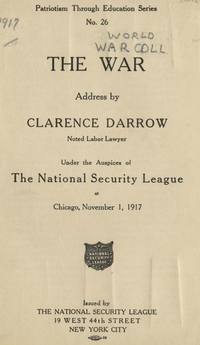 The War address by Clarence Darrow. Clarence Darrow was an admirer of Tolstoy's philosophy of non-violence but when Germany began World War I, Darrow quickly dropped his non-violence philosophy and publicly supported the entry of the United States in the conflict in Europe. Cover from pamphlet of address Darrow gave in support of the war. |
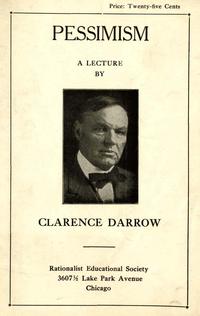 Pessimism: A Lecture by Clarence Darrow. Clarence Darrow often displayed a pessimistic outlook. Many of his lectures were published and sold as pamphlets. This lecture was held on Sunday, January 11th, 1920, Kimball Hall, Chicago. |
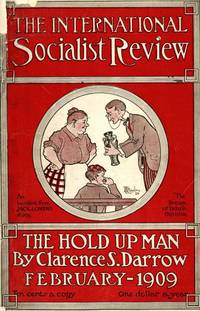 Cover from magazine featuring a story by Clarence Darrow. |
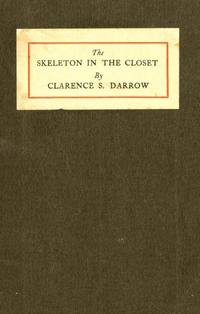 The Skeleton in the Closet by Clarence Darrow. Cover from 1925 pamphlet containing Clarence Darroddw's short story. The Skeleton in the Closet was first published in 1899. |
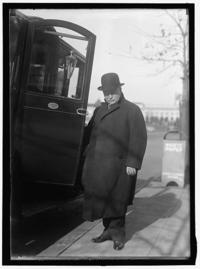 Victor L. Berger. On March 1, 1931 the Victor L. Berger National Foundation was founded in Washington D.C. Clarence Darrow accepted the position as the foundation's first president. Library of Congress Prints and Photographs Division, LC-DIG-hec-02451. |
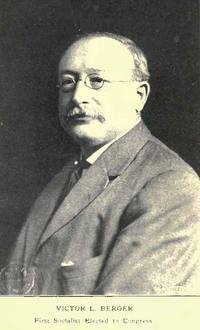 Victor L. Berger. |
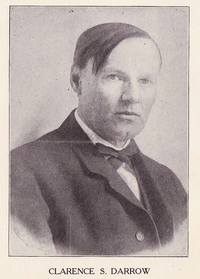 Clarence S. Darrow. Clarence Darrow's portrait from a 1908 Finnish translation of his book An Eye for An Eye titled Silma Silmasta. |
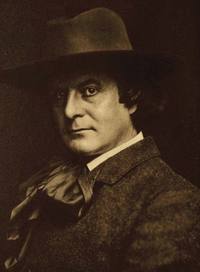 Elbert Hubbard. Elbert Green Hubbard (1856 - 1915) was writer, publisher, artist, and philosopher and a prominent member of the Arts and Crafts movement. In 1895, he founded Roycroft a community of craft workers and artists in East Aurora, New York. Clarence Darrow's first book, A Persian Pearl and Other Essays was published by Hubbard's Roycroft publishing company. A friend of Darrow, Hubbard and his wife were killed on May 7, 1915 when the Lusitania was torpedoed and sunk by a German submarine killing 1,198 people. In June 1930 Clarence Darrow and others participated in a birthday celebration for the late Elbert Hubbard in East Aurora. Darrow gave a talk about Hubbard. |
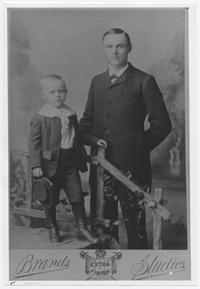 Clarence Darrow and His Son Paul. Clarence Darrow's only child Paul was born December 10,1883. Letters Related to Paul Darrow |
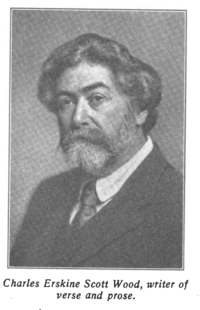 Charles Erskine Scott Wood . Charles Erskine Scott Wood (1852 - 1944) was an attorney, writer, soldier and civil libertarian. He was a prominent attorney in Portland, Oregon. Wood and Clarence Darrow were friends and for a time Darrow carried on an affair with Mary Parton, the sister of Wood's wife Sara Bard Field. It was Darrow who introduced Wood to Sara Field. Wood fought in the Nez Perce War in 1877 and participated in the capture of Chief Joseph. Wood and Joseph later became friends. Wood's daughter, Nan Wood Honeyman, was the first U. S. congresswoman from Oregon. |
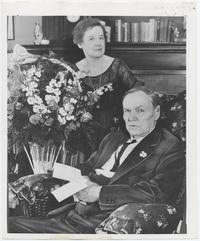 Ruby and Clarence Darrow. Letters Related to Ruby Darrow |
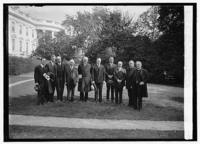 Lord's Day Alliance Group. The Lord's Day Alliance of the United States (LDA) was founded in 1888 when representatives from six major Protestant denominations met in Washington, D.C. to organize the American Sabbath Union. The name was later changed to The Lord's Day Alliance of the United States. Still active, the LDA describes itself as "the one national organization whose sole purpose is to maintain and cultivate the first day of the week as a time for rest, worship, Christian education and spiritual renewal." Clarence Darrow published a sharp criticism of the LDA that was published in Plain Talk (volume 2, pp. 257-70, March 1928) in which he began: "Among the various societies that are engaged in the business of killing pleasure, the Lord's Day Alliance of New York deserves a place of honor. If any poor mortal is caught enjoying life on Sunday its agents gleefully hie themselves to the nearest legislature and urge a law to stop the fun. Their literature and periodicals tell very plainly the kind of business they are in. This association of crape-hangers seems to be especially interested in the State of New York, which contains about one-tenth of the population of the Union, and among them an unusually large number of foreigners and other heathen who have not been taught the proper regard for the sanctity of the Sabbath." Reportedly, H. L. Mencken reluctantly declined to publish the article in his American Mercury because he thought it was too harsh although he agreed with Darrow's points. Library of Congress Prints and Photographs Division, LC-DIG-npcc-24752. |
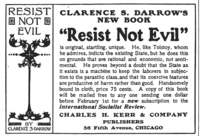 Ad for Resist No Evil by Clarence S. Darrow. From The Public in 1902. |
 Humorous picture of Clarence Darrow. Picture included in After Dinner Stories by Famous Men, which contained a brief account of a humorous story about Clarence Darrow as a young lawyer. |
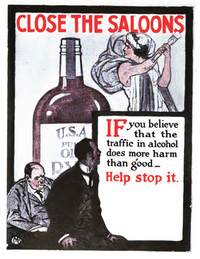 Close the Saloons. Prohibition poster. |
 Free Speech and Free Press. Announcement that Clarence S. Darrow will speak published in The Public (1901). |
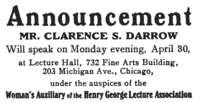 Mr. Clarence S. Darrow Will Speak. Announcement in The Public in 1906. |
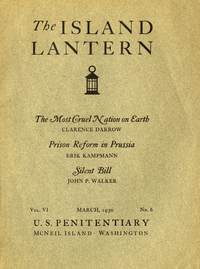 The Most Cruel Nation on Earth by Clarence Darrow. Cover from a prison magazine titled the Island Lantern published at the U.S. Penitentiary, McNeil Island, Washington. Clarence Darrow's article is very critical of the criminal sentencing policies in the United States. |
 Horace Greeley. Horace Greeley (1811 - 1872) owned the New York Tribune which was considered one of America's most influential newspapers from the 1840s to the 1870s. He was also a reformer and politician and founder of the Liberal Republican Party. Greeley lost the 1872 U.S. presidential election to the Republican incumbent President Ulysses S. Grant. Clarence Darrow recalls Greeley and this election: "From my youth I was always interested in political questions. My father, like many others in northern Ohio, had early come under the spell of Horace Greeley, and, as far back as I can remember, the New York Weekly Tribune was the political and social Bible of our home. I was fifteen years old when Horace Greeley ran for the presidency. My father was an enthusiastic supporter of Greeley and I joined with him; and well do I remember the gloom and despair that clouded our home when we received the news of his defeat." Clarence Darrow, The Story of My Life. Library of Congress Prints and Photographs Division, LC-USZ62-47450. |
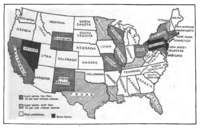 Prohibition Map. From The Cyclopedia of Temperance, Prohibition and Public Morals (1917) by Deets Pickett, Clarence True Wilson, Ernest Dailey Smith. Clarence Darrow debated Clarence True Wilson, one of the authors of this book, forty-six times on the subject of Prohibition. The two came to be very close friends despite their differences about this subject. |
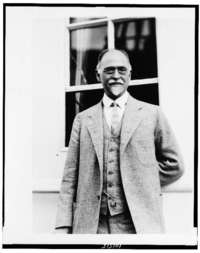 Professor Irving Fisher of Yale University. Professor Irving Fisher was a leading prohibitionist, economist, health campaigner, and eugenicist. He was one of the most prominent and most celebrated economists in America during the early part of the twentieth century. He is credited with pioneering many of the principles that are the foundation of central bank policy. Fisher was financially wiped out during the Great Depression. He also invented the Rolodex. In 1927 Clarence Darrow and Victor S. Yarros wrote a book titled The Prohibition Mania: a Reply to Professor Irving Fisher and Others. They wrote the book to refute Fisher's book Prohibition at Its Worst. Library of Congress Prints and Photographs Division, LC-USZ62-101515. |
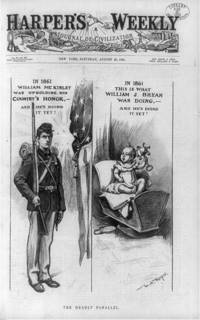 The Deadly Parallel. In 1896 Governor John Peter Altgeld was running for re-election and he persuaded a reluctant Clarence Darrow to run for Congress. William Jennings Bryan ran for president. After the ballots were counted, Bryan lost the election to McKinley, Altgeld lost the governorship and Darrow lost his race. Cartoon showing William McKinley as soldier in 1861 and William Jennings Bryan as baby in cradle in 1861. Illustrated in: Harper's Weekly, v. 40, no. 2071, 1896 August 29, cover. Library of Congress, LC-USZ62-97504. |
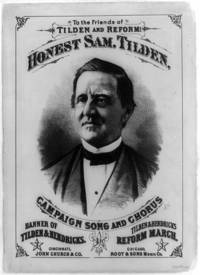 Honest Sam Tilden. Samuel Jones Tilden (1814 - 1886) was the Democratic candidate in the disputed United States presidential election of 1876, one of the most controversial elections in U.S. history. Clarence Darrow became interested in politics as early as age fifteen when his father enthusiastically supported Horace Greeley for president in 1872. In the 1876 race his family supported Samuel Tilden while most of their neighbors supported Rutherford B. Hayes. The Tilden campaign prompted the young Darrow to become knowledge about political issues. Library of Congress Prints and Photographs Division, LC-USZ62-89311. |
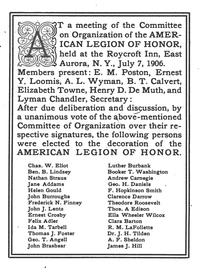 American Legion of Honor. Clarence Darrow along with several others were elected to the "decoration of the American Legion of Honor" in July 1906. Others elected included Theodore Roosevelt, Thomas A. Edison, Jane Addams, Booker T. Washington, Andre Carnegie and R.M. LaFollette. Published in Little Journeys to the Homes of Great Lovers by Elbert Hubbard. |
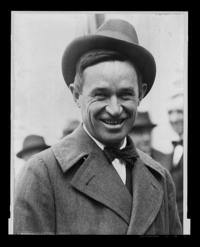 Will Rogers. Will Rogers was a vaudeville performer, actor, humorist and Cherokee-American cowboy. During a period in the mid 1930s he was the highest paid movie star in Hollywood. In 1932 Clarence Darrow wrote to Rogers on behalf "a kinsman of mine, Mr. Whitney Darrow, who is one of the heads of "the Charles Scribner's Sons publishing company". Darrow told Rogers that the publisher was "anxious to have a book" by Rogers published. The Papers of Will Rogers: The Final Years, August 1928 - August 1935, at 347, by Will Rogers, et. al. Library of Congress Prints and Photographs Division, LC-USZ62-20553. |
 Advertisement for Clarence Darrow's 1932 Autobiography. Courtesy of the Special Collections Department, University of Iowa Libraries. |
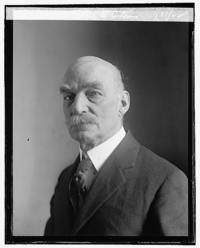 Theodore Brentano. Theodore Brentano (1854 - 1940) was a lawyer and an Illinois state judge. In 1922 he was appointed as the first American ambassador to Hungary by President Warren G. Harding. Brentano sent Clarence Darrow a Christmas and New Year's greeting in December 1924 on the stationary of the American Legation Budapest. Library of Congress Prints and Photographs Division, LC-DIG-npcc-05720. Brentano Letter to Darrow |
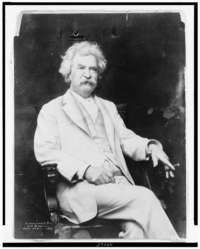 Mark Twain c. 1907. Clarence Darrow thought highly of Mark Twain's writing. In a 1917 letter to his son Paul he wrote "Have you seen Mark Twains new book The Mysterious Stranger, it is a peach." Library of Congress, LC-USZ62-112065. |
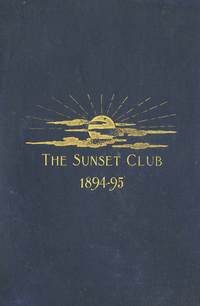 The Sunset Club 1894-95. Clarence Darrow joined the Sunset Club soon after moving to Chicago. The club was created to "foster rational good fellowship and tolerant discussion among business and professional men of all classes." And "Any genial and tolerant fellow may become a member on approval of the executive committee." It met at a dinner once a month on a Thursday evening to hear short talks on a topics selected by the Secretary. Darrow became a member of the executive committee. Many of its discussions were published. This is the cover from one of its publications. |
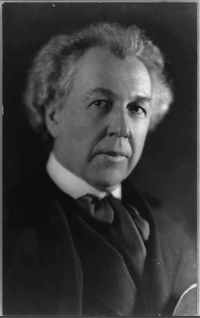 Frank Lloyd Wright. Frank Lloyd Wright (1867 - 1959) was a famous American architect. Clarence Darrow knew Wright and performed some legal work for him. Library of Congress Prints and Photographs Division, LC-USZ62-36384. |
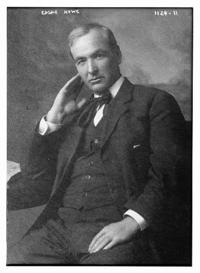 E.W. Howe. Edgar Watson Howe (1853 - 1937), commonly referred to as E. W. Howe, was a newspaper and magazine editor and a novelist. He was known for his magazine, E.W. Howe's Monthly. Howe was a friend of Clarence Darrow. Library of Congress Prints and Photographs Division, LC-DIG-ggbain-05600. |
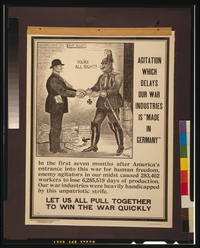 World War I Poster. Poster showing a man "Agitator" shaking hands with and receiving an Iron Cross from the Kaiser in "Plot Alley." A tiny bird comments, "He'll get the double cross from him later." Issued by the National Industrial Conservation Movement. Clarence Darrow supported the entry of the United State into World War I but he was concerned about the civil liberties of those opposed to the war. Library of Congress Prints and Photographs Division, LC-USZC4-7842. |
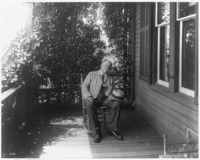 William Dean Howells c. 1908. William Dean Howells was an author, editor, and critic. He was the editor of the Atlantic Monthly from 1871 - 1881. Referred to as the "Dean of American Letters," he was elected the first president of the American Academy of Arts and Letters in 1908. Howells corresponded with Darrow and in 1904 tried to help Darrow get a manuscript called Story of My Life published. The book was eventually published with the title Farmington. Library of Congress Prints and Photographs Division, LC-USZ62-61301. |
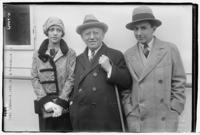 Rosabelle, Carl Laemmle, Carl Jr. Carl Laemmle Sr. was a founder of Universal Pictures. Rosabelle was his only daughter. His son, Carl Laemmle Jr., was in charge of production at Universal Studios from about 1928 to 1936. In 1931 Clarence Darrow narrated and appeared in a film about evolution titled Mystery of Life that was distributed by Carl Laemmle Sr. Darrow and Laemmle corresponded by letter. Library of Congress Prints and Photographs Division, LC-DIG-ggbain-38710. |
 Notice Announcing Lectures by Clarence Darrow (1895). Published in The Cause by the Society for Ethical Culture of Philadelphia. |
 The "Hooch hound" in Action. Man seated on pier, with pipe in his mouth, fishing on the Potomac River, as dog trained to detect liquor takes a bottle from his back pocket. Library of Congress, LC-USZ62-96718. |
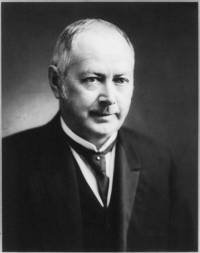 Albert Sidney Burleson. Albert Burleson was appointed Postmaster General by Woodrow Wilson in 1913. During World War I, Burleson strongly enforced the Espionage Act by ordering local postmasters to remove and send to him any illegal or suspicious material such as radical publications which included Socialist material. Anti-war material was banned from delivery. Clarence Darrow complained to President Wilson, who wrote a letter to Darrow on August 9, 1917. In the letter he told Darrow, "You may be sure I will try to work out with the Postmaster General some course with regard to the circulation of the Socialistic papers that will be in conformity with the law and good sense." Library of Congress Prints and Photographs Division, LC-USZ62-62930. |
 Entrance to United States Government War Exhibition, September 8, 1918. One quarter of a million people in attendance. Library of Congress Prints and Photographs Division, pan 6a27671 http://hdl.loc.gov/ loc.pnp/pan.6a27671 |
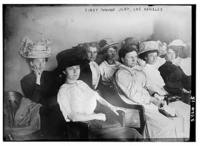 First Woman Jury, Los Angeles. On November 3, 1911 this all-woman jury acquitted A.A. King, editor of the Watts News of obscenity charges. Clarence Darrow was skeptical of women on juries. He wrote an article titled "Women and Justice: Are Women Fit to Judge Guilt?" that was published in McCall's in June 1928. In a 1936 article published in Esquire Magazine titled "Attorney for the Defense" Darrow wrote: "Then, too, there are the women. These are now in the jury box. A new broom sweeps clean. It leaves no speck on the floor or under the bed, or in the darkest comers of life. To these new jurors, the welfare of the state depends on the verdict. It will be so for many years to come ... Women still take their new privilege seriously. They are all puffed up with the importance of the part they feel they play, and are sure they represent a great step forward in the world. They believe that the sex is co-operating in a great cause. Like the rest of us, they do not know which way is forward and which is backward, or whether either one is any way at all. Luckily, as I feel, my services were almost over when women invaded the jury box." Library of Congress Prints and Photographs Division, LC-DIG-ggbain-10079. |
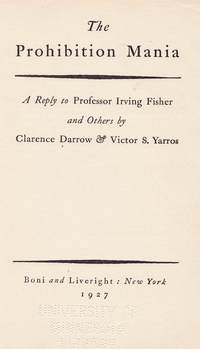 The Prohibition Mania: A Reply to Professor Irving Fisher and Others by Clarence Darrow & Victor S. Yarros. Clarence Darrow and Victor Yarros published this book in 1927 to refute the book Prohibition at Its Worst written by a leading prohibitionist Professor Irving Fisher of Yale University. |
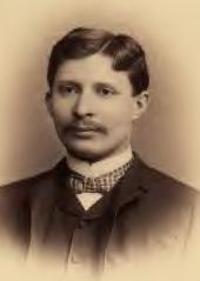 Victor Yarros. http://en.wikipedia. org/wiki/File: VictorYarros.jpg |
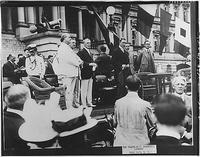 William Jennings Bryan, President Woodrow Wilson, Franklin D. Roosevelt. Clarence Darrow received personal letters from these three historic figures. William Jennings Bryan is on the left in white suit. To his left in dark suit coat is President Woodrow Wilson. On the far right side is Franklin D. Roosevelt. Others in the photo are Josephus Daniels, Breckinridge Long, and William Phillips. Photo was taken at the State Department, June 14, 1914. Library of Congress Prints and Photographs Division, LC-USZ62-10466. |
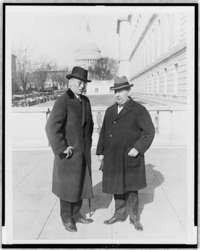 Assistant Secretary of the Treasury and Prohibition Czar Lincoln C. Andrews and the Commissioner of Prohibition, Roy C. Haynes outside of the House of Representatives [between 1925 and 1927]. Library of Congress Prints and Photographs Division, LC-USZ62-118170. |
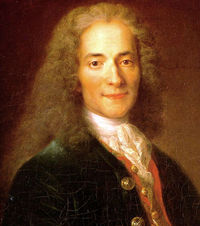 Voltaire in 1718 at age 24. Voltaire was the pen name for Francois-Marie Arouet. Clarence Darrow greatly admired Voltaire. http://en.wikipedia.org/wiki/File:Voltaire.jpg |
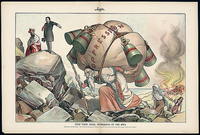 Stop Your Cruel Oppression of the Jews. A vicious pogrom against Jews in Kishinev, Russia occurred on April 6 & 7, 1903. The attacks began after a Christian Russian boy was found murdered in the town of Dubăsari. Over the course of three days, a mob attacked Jews, committing murder and rape. Several babies were murdered. The local government not only failed to protect the victims but some of the leaders of the mob were government officials. Between 45 and 60 people were murdered, over 600 injured, over 1500 shops destroyed, 12,000 homes damaged and about 2000 families left homeless. Clarence Darrow joined Jane Addams and Peter Sissman to denounce the atrocities and anti-Semitism during a presentation at the Star Theater in Chicago on April 18, 1903. Print shows an aged man labeled "Russian Jew" carrying a large bundle labeled "Oppression" on his back; hanging from the bundle are weights labeled "Autocracy," "Robbery," "Cruelty," "Assassination," "Deception," and "Murder." In the background, on the right, a Jewish community burns, and in the upper left corner, Theodore Roosevelt speaks to the Emperor of Russia, Nicholas II, "Now that you have peace without, why not remove his burden and have peace within your borders?" Library of Congress Prints and Photographs Division, LC-DIG-ppmsca-05438. |
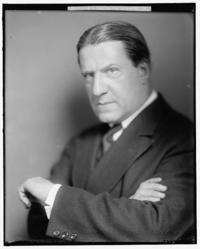 Rabbi Stephen Wise. Clarence Darrow had many Jewish friends and denounced anti-Semitism but he never supported a separate homeland for Jewish people. In 1927, he debated Rabbi Stephen S. Wise over the issue: Is Zionism a Progressive Policy for Israel and America? Rabbi Wise argued in the affirmative and Darrow argued in the negative during the debate held at the Sinai Temple in Chicago on October 24, 1927. Library of Congress Prints and Photographs Division, LC-DIG-hec-19183. |
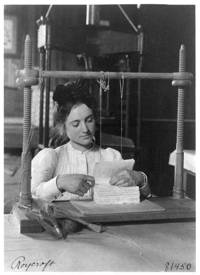 Woman Doing Bookbinding at Roycroft Shops, East Aurora, New York c. 1900. In 1899 Clarence Darrow published his first book titled A Persian Pearl and Other Essays. The book was published by Elbert Hubbard, the operator of The Roycroft Shop of East Aurora, New York. Darrow was good friends with Hubbard. Library of Congress Prints and Photographs Division, LC-USZ62-88604. |
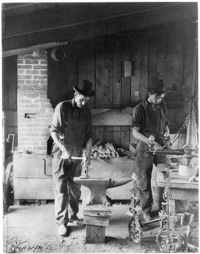 Roycroft Shop, East Aurora, New York 1900. Roycroft was a very successful Arts and Crafts community founded by Elbert Hubbard around 1895. Clarence Darrow was friends with Hubbard and The Roycroft Shop published Darrow's first book A Persian Pearl and Other Essays in 1899. Library of Congress Prints and Photographs Division, LC-USZ62-83102. |
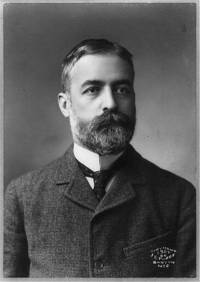 Ernest Howard Crosby c. 1904. Ernest Crosby (1856 - 1907) was a reformer and author born in New York City. He was greatly influenced by Count Leo Tolstoy with whom he became good friends. Clarence Darrow was one of the individual sponsors to the Ernest Howard Crosby Memorial Committee in 1907. Library of Congress Prints and Photographs Division, LC-USZ62-73277. |
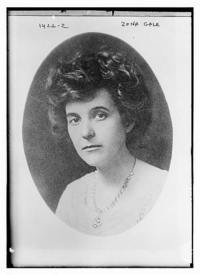 Zona Gale. Zona Gale (1874 - 1938) was American author and playwright. Born in Portage, Wisconsin she became known as a fiction writer. She wrote a very popular series called "Friendship Village." Gale also wrote a novel titled Miss Lulu Bett which she adapted as a play and for which she won the Pulitzer Prize for Drama in 1921. Active in the National Women's Party Gale lobbied for the enactment of the Wisconsin Equal Rights Law. Enacted in 1921, the law prohibited discrimination against women. Gale and Clarence Darrow were friends. Library of Congress Prints and Photographs Division, LC-DIG-ggbain-07909. |
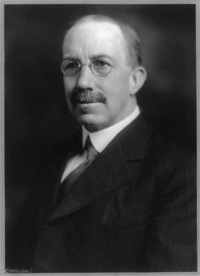 Wayne Bidwell Wheeler c. 1920. Wayne Wheeler was a lawyer and staunch prohibitionist. He served as attorney and general counsel for the National Anti-Saloon League. The Anti-Saloon League was the most influential and powerful organization lobbying for Prohibition in the United States in the early 20th century. Darrow wrote in his autobiography: "Like many other evils, prohibition was adopted under the cloak of the great World War. It was brought about under the guise of a bill for the conservation of food. The men who were responsible for it were much more anxious to prohibit the use of liquor than they were to win the war. The story has been told in a very naive way by Doctor Irving Fisher in his book entitled Prohibition at Its Worst. The committee that had charge of food conservation in the conduct of the war was deliberately packed by Wayne Wheeler, Doctor Irving Fisher, and others, so that the food bill should forbid the use of any intoxicating liquor during the war. It was intended that no one opposed to the plot should have any notice of what was going on. Unfortunately, one man out of several hundreds who were trusted with the secret revealed it just in time to prevent the bill passing as the conspirators had designed. Doctor Fisher, for his services in the matter, earned the enduring fame of receiving from Wayne Wheeler the compliment that he had done more for prohibition than any man in America wearing shoe leather. Wayne Wheeler and the rest of the fanatical drys did their best to tie up the whole bill for food conservation unless President Woodrow Wilson would consent to the prohibition clause. As between their fanaticism for making the country dry or winning the war, there was no question as to the stand maintained by Mr. Wheeler and his supporters." Library of Congress Prints and Photographs Division, LC-USZ62-72978. |
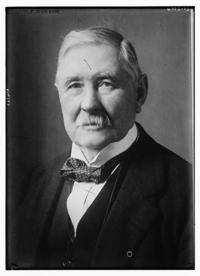 T.P. O'Connor. Thomas Power O’Connor (1848 - 1929), commonly referred to as "T. P.", was born in Athlone, County Westmeath, Ireland. O’Connor was a journalist, an Irish nationalist politician, and a Member of Parliament (MP) in the House of Commons of the United Kingdom of Great Britain and Ireland for nearly fifty years. He founded T.P.’s Weekly in 1902. In his autobiography, Clarence Darrow wrote: “I believe I should mention a few well-known Britons that Mrs. Darrow and I saw day after day. One was the Irish-English statesman, T. P. O'Connor. I met him first in America during the war, and it happened that we crossed the Atlantic together; and after that I saw him every time I was in Europe. T. P. O'Connor was a real statesman, the oldest member of Parliament at the time of his death. He was a kindly, lovable man, with a sense of humor that infected all who had the luck to come into his presence. He was ill when we were in London that last time we met, and almost every evening we were at his home in Morpeth Mansions; for weeks before the end he was having dinner-parties, inviting as many as could be accommodated. Doubtless he felt the shadow hanging over his head, and wanted to see us as often as possible. He loved his friends and was a wonderful host, sipping a few drops from his champagne-glass, toasting us all to our long lives and happiness, never admitting that he was really ill, until gradually he grew weaker and it was evident that he could not recover. We were there early on the very evening before his death. He always talked affectionately of America, and regretted that he should not see it again. No man in Great Britain was more deeply loved and honored than this great human Irishman, T. P. O'Connor.” Library of Congress Prints and Photographs Division, LC-DIG-ggbain-36019. |
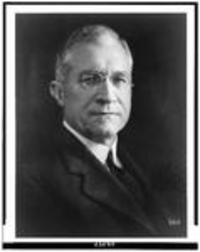 John Haynes Holmes. Clarence Darrow debated his friend Dr. John Haynes Holmes, pastor of the Community Church in New York on December 23, 1924. The debated was titled "Resolved: That the United States Continue the Policy of Prohibition as Defined in the Eighteenth Amendment." At one point during his presentation Darrow remarked: "Take out of this world the men who have drunk, down through the past, and you would take away all the poetry and literature and practically all the works of genius that the world has produced. What kind of poem do you suppose you would get out of a glass of ice-water?" Library of Congress, LC-USZ62-112447. |
 Jane Addams c. 1907. Jane Addams was a co-founder of the social settlement Hull-House in Chicago. Clarence Darrow knew Jane Addams. Darrow recounted that for former Governor John Peter Altgeld's funeral "two invitations were sent to clergymen, supposed to be liberal-minded, asking them to conduct the farewell ceremony, but both found reasons for not being able to come. So Miss Jane Addams, of Hull House, a woman of rare ideals and intelligence, was asked to speak. Governor Altgeld had long admired Miss Addams, and was often a visitor at Hull House, and she had always understood and appreciated the fearlessness and unselfishness of the man. Her words were simple and sensible, such as she always uses." Library of Congress, LC-USZ62-95722. Addams Letter to Darrow |
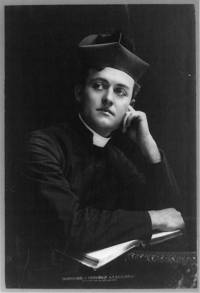 Richard Bennett as Father Anselem, in "A Royal Family". Richard Bennett (1870 - 1944) was a film star and father of actresses Constance Bennett and Joan Bennett. An friend of Clarence Darrow, Bennett wrote several letters to Darrow in the 1930s. Library of Congress Prints and Photographs Division, LC-USZ61-1686. Bennett Letters to Darrow |
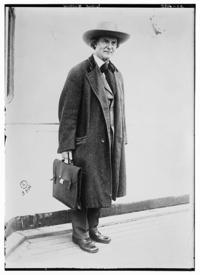 Elbert Green Hubbard onboard the Lusitania. Elbert Green Hubbard (1856 - 1915) was a writer, publisher, artist, and philosopher who was very influential in the Arts and Crafts movement. In 1895, he founded Roycroft a community of craft workers and artists in East Aurora, New York. Hubbard is also remembered for writing A Message to Garcia an inspirational essay that became an international hit. A friend of Clarence Darrow, Hubbard and his wife were killed on May 7, 1915 when the Lusitania was torpedoed and sunk by a German submarine killing 1,198 people. Library of Congress Prints and Photographs Division, LC-DIG-ggbain-32076. |
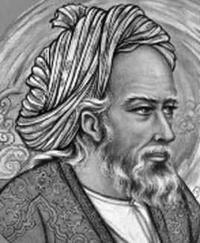 Omar Khayyam. Omar Khayyam (1048 - 1123) was a Persian mathematician, astronomer, and poet. He was largely unknown to English-speaking readers until a collection of his quatrains were translated in The Rubaiyat of Omar Khayyam by the English writer Edward FitzGerald in 1859. Darrow was particularly fond of Khayyam and quoted from the Rubaiyat in some of his closing arguments and in his autobiography. http://en.wikipedia.org /wiki/File: Omar_Chayyam.jpg |
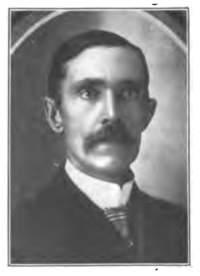 Edward Everett Darrow. Edward Everett Darrow (1846 - 1927) was Clarence Darrow's oldest sibling. Photo from the History of the Class of '70, Department of Literature, Science and the Arts published by the University of Michigan documenting the class of 1870. Clarence Darrow letter referring to his brother whom he refers to as Everett. |
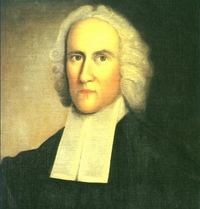 Jonathan Edwards. In October 1925 Clarence Darrow took on the issue of eugenics in an article he wrote titled "The Edwardses and the Jukeses" published in the American Mercury (volume 6, pp 147-57). The Jukes was a pseudonym for a family from the lower class of society used by proponents of eugenics to illustrate a genetic disposition for anti-social behavior or low intelligence and in the case of the Jukes for inherited criminality. The example of the Jukeses originally began with Richard L. Dugdale's The Jukes: A Study in Crime, Pauperism, Disease and Heredity in 1877. The Edwardses refers to descendants of Jonathan Edwards (1703 - 1758) a fire and brimstone preacher and important theologian in early America. Darrow wrote that he would rather live next to a member of the Jukes clan than next to a descendant of Jonathan Edwards who, in his most famous sermon, preached that "The God that holds you over the pit of hell, much as one holds a spider over the fire, abhors you, and is dreadfully provoked; His wrath towards you burns..." (This is an excerpt from Edward's Sinners in the Hands of an Angry God). https://en.wikipedia.org /wiki/Jonathan_Edwards _(theologian) |
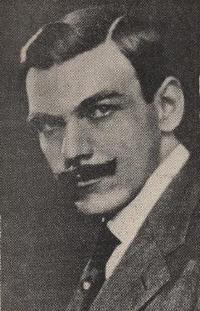 Lothrop Stoddard. Dr. Lothrop Stoddard (1883 - 1950) was a political scientist, historian, writer, and anthropologist. His advocacy of eugenics and anti-immigration are forms of scientific racism. One of his most well-known works was his 1920 book The Rising Tide of Color Against White World-Supremacy. Despite its title, Stoddard also criticized white nations for invading nations of other races. Clarence Darrow debated Stoddard on the issue "Is the U.S. Immigration Law Beneficial?" Stoddard argued in the affirmative and Darrow argued in the negative on the resolution: "That the Immigration Law discriminating in favor of the races of Northern Europe as opposed to those of Southern Europe is an advantage to the United States." http://en.wikipedia. org/wiki/Lothrop_Stoddard |
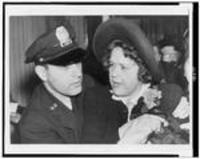 Elizabeth Dilling Stokes being escorted from the U.S. Capitol for leading an anti-war demonstration in 1941. Elizabeth Dilling Stokes (1894 - 1966) was an anti-communist and anti-war activist and writer. In 1934 she wrote The Red Network: A "Who's Who" and Handbook of Radicalism for Patriots in which she listed purported communists to expose communist front activity in the United States. Clarence Darrow was included in the book along with many of his friends and associates. Library of Congress, LC-USZ62-111260. |
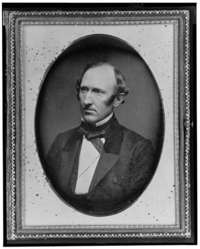 Wendell Phillips [between 1853 and 1860]. Wendell Phillips (1811 - 1884) was an American abolitionist. He was also a strong advocate for the rights of Native Americans. Phillips was a noted orator, debater and lawyer. Darrow wrote in his 1904 semi-autobiographical work Farmington: "As a little child, I heard my father tell of Frederick Douglass, Parker Pillsbury, Sojourner Truth, Wendell Phillips, and the rest of that advance army of reformers, black and white, who went up and down the land arousing the dulled conscience of the people to a sense of justice to the slave. They used to make my father's home their stopping-place, and any sort of vacant room was the forum where they told of the black man's wrongs." Library of Congress Prints and Photographs Division, LC-USZ62-129165. |
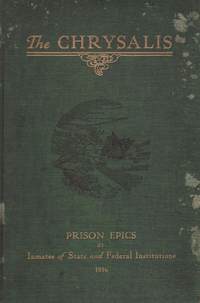 THE CHRYSALIS: Prison Epics by Inmates of State and Federal Institutions. Clarence Darrow wrote a short article entitled "Punishment" for this publication in 1916. Article is available above. |
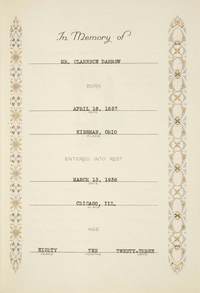 In Memory of Mr. Clarence Darrow. Cover from the funeral book from a memorial service held for Clarence Darrow in Bond Chapel at the University of Chicago on March 15, 1938. The full-text of the funeral book is available above. Courtesy of Special Collections Research Center, University of Chicago Library. |
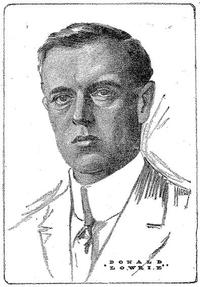 Donald Lowrie. Donald Lowrie was convicted of burglary and sentenced to fifteen years in San Quentin State Prison. He served ten years and after being released he wrote a book called My Life in Prison published in 1912 in which he argued for prison reform. He later wrote My Life Out of Prison in which he briefly discussed Clarence Darrow's stance against capital punishment. Lowrie had heard Darrow testify before the California legislature on this topic. Lowrie was an influential prison reformer. http://en.wikipedia.org /wiki/File: Donald_Lowrie.jpg |
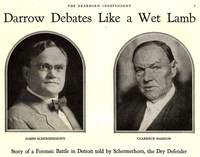 Darrow Debates Like a Wet Lamb. Clarence Darrow debated James Schermerhorn, founder and president of the Detroit Times, about prohibition in 1925. Schermerhorn wrote an article about the dabate titled "Darrow Debates Like a Wet Lamb" that was published in Henry Ford's Dearborn Independent Magazine in the January 2, 1926 edition. |
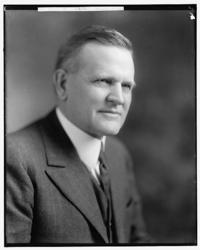 Irvine Luther Lenroot. Irvine Luther Lenroot (1869 - 1949) was a U.S. Senator from Wisconsin and he also served as a judge of the U.S. Court of Customs and Patent Appeals from 1929 to 1944. On December 11, 1925 Clarence Darrow debated Lenroot about whether the United States should join the World Court. During the debate at Princeton University Darrow "ridiculed the World Court as an institution without power, with no way of enforcing its decrees, of no value anyway and an inevitable step toward the participation of this country in the League of Nations." COLLEGIANS DEMAND WE ENTER THE COURT, New York Times, Dec. 11, 1925. p. 19. Library of Congress Prints and Photographs Division, LC-DIG-hec-16210. |
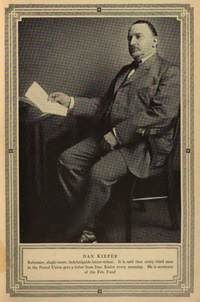 Dan Kiefer. Clarence Darrow wrote a letter to his friend Daniel Kiefer that was published in The Liberal Review in July 1917. Kiefer had criticized Darrow for turning away from pacifism and supporting America's involvement in World War I. Darrow wrote in reply to this criticism. Photo from The American Magazine, (1912). |
 Announcement that Clarence Darrow and Another Person will appear in an industrial play. The notice also mentions that Darrow has been lecturing on behalf of liquor dealers. From The Shop Review. |
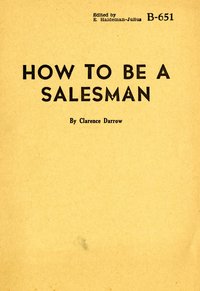 How To Be A Salesman by Clarence Darrow. Cover from pamphlet containing an article Darrow originally wrote for the American Mercury in 1925. |
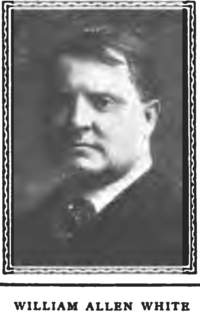 William Allen White. William Allen White was a well-known newspaper editor, author and owner of the Emporia Gazette. Clarence Darrow and White were friends and corresponded by letter. |
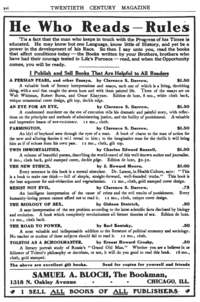 Ad for Books by Clarence Darrow and Others. Four of the books are by Clarence Darrow. One is by John Howard Moore (1862 - 1916) who was married to Clarence Darrow's sister Jennie. Moore was a high school teacher who was also a prolific writer of some renown on evolutionary biology and ethics. Another author featured is Charles Edward Russell (1860 - 1941), a friend of Darrow. Russell was a journalist, author, political activist and a cofounder of the NAACP. He was a member of the Socialist Party prior to World War I. In 1934 he served on the National Recovery Administration Review Board chaired by Clarence Darrow. Published in The Twentieth Century Magazine (1910). |
 47th Annual Continental Congress of the Daughters of the American Revolution Convention, Washington, D.C. In 1928 the Daughters of the American Revolution circulated a list of what it termed "Doubtful Speakers" that it wanted to bar from speaking at D.A.R. events. Clarence Darrow made the list because he was considered a "Socialist." There were many others on the list including, Arthur Garfield Hays, Benjamin Gitlow, Dudley Field Malone, William Allen White, Roscoe Pound and Felix Frankfurter at Harvard law School, Rabbi Stephen S. Wise, W.E.B. Du Bois, Jane Addams, and Harry Emerson Fosdick. There were also many organizations on the list. The D.A.R. did not actually draw up the list, this was done by other individuals and organizations, but several of those on the list attacked the D.A.R. |
 Margaret Sanger. Margaret Sanger (1879 - 1966) was a birth control activist who founded the American Birth Control League in 1921 which became the Planned Parenthood Federation of America in 1942. In 1914 Sanger was indicted by federal authorities for violating postal regulations by advocating birth control in her newsletter The Woman Rebel. She fled to England but returned in 1915. Clarence Darrow and other lawyers offered to defend Sanger but she turned them down because "I was convinced that the quibbles of lawyers inevitably beclouded the fundamental issues; I had to move people and persuade them emotionally." The Autobiography of Margaret Sanger 185 (2004). Library of Congress Prints and Photographs Division, LC-DIG-ggbain-23669. |
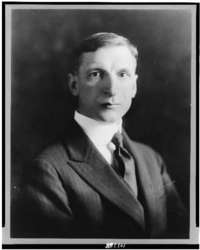 Eamon de Valera c 1919. Eamon de Valera (1882 - 1975) was an Irish politician and patriot born in America. He consulted with Clarence Darrow in Chicago just a few weeks after he escaped from Britain's Lincoln Jail on February 3, 1919. He was an important figure in the Easter Rising, the Irish War for Independence from Britain, and the Irish Civil War. He later became Prime Minister (Taoiseach) of Ireland from 1951 to 1959 and President from 1959 to 1973. Library of Congress, LC-USZ62-103868. |
 Voltairine de Cleyre. Although largely unknown outside anarchist circles Voltairine de Cleyre (1866 - 1912) is considered one of the most important anarchist thinkers and writers in the history of the movement in the United States. According to several sources, de Cleyre heard a presentation by Clarence Darrow about socialism at a Paine memorial convention in Pennsylvania that led her to study socialism. One source states that de Cleyre attended this presentation by Darrow in 1887. However, she quickly gave up socialism for anarchism. Photo from Selected Works of Voltairine de Cleyre (1914). |
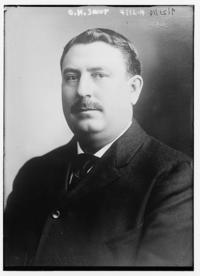 Oliver H. Shoup. Governor Shoup served as the governor of Colorado from 1919 to 1923. Clarence Darrow met Governor Shoup in 1919 and wrote in a letter to his son Paul that the governor "heard one of my debates & seemed to have a good time. He is a bully good fellow..." |
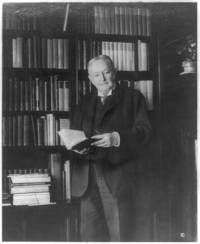 Joseph Hodges Choate. Joseph Hodges Choate (1832 - 1917) was a lawyer and diplomat. Choate was one of the most prominent lawyers in the country and was involved in many important cases during his career. He was chosen as the first president of the National Security League, a public service organization founded in 1914 to lobby for increased and improved preparation for America's defense from enemies at home and abroad. Most of Clarence Darrow's speeches supporting America's entry into World War I were made under the auspices of the National Security League. Library of Congress Prints and Photographs Division, LC-USZ62-37214. |
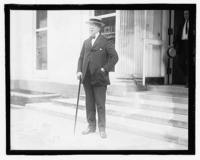 James M. Beck. James M. Beck (1861 - 1936) was a highly regarded lawyer and politician from Philadelphia, Pennsylvania. Beck was a member of the Republican Party and served as U.S. Solicitor General (1921 - 1925) and U.S. Representative from Pennsylvania (1927 - 1934). In March 1931 Clarence Darrow participated as defense counsel in a mock trial of Benedict Arnold. Beck played the prosecutor. A group of eminent men and women were enlisted as a "radio jury" and listened to the trial over the radio and rendered a guilty verdict by telegraph. The trial was produced by the National Dairy Products Corporation and was broadcast over numerous radio stations on March 22nd and 29th. Library of Congress Prints and Photographs Division, LC-DIG-npcc-06923. |
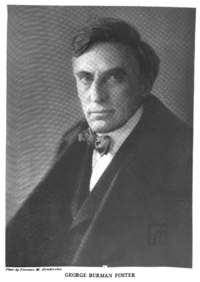 George Burman Foster. George Burman Foster (1857 - 1918) was a professor of philosophy of religion at the University of Chicago from 1905 until his death in 1918. Sometime in 1906 Clarence Darrow met Foster and they became very good friends. Darrow considered Foster, a famous theologian during his time, one of the most learned men he had ever met. Photo from The University Record (1919). |
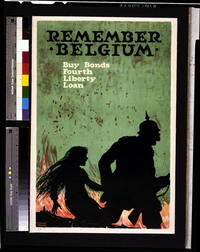 Remember Belgium: Buy Bonds Fourth Liberty Loan. "German soldier, wearing pointed helmet, leading girl by hand, with city burning in background." Because he was an outspoken supporter of the allied war effort during World War I, Clarence Darrow was invited by the British government to spend three months in Europe in the summer of 1918 to bolster support. An important result of the trip was that Darrow came to believe that the British and French governments had deliberately spread propaganda by claiming repeatedly that the German military committed war crimes. This was later found to be the case as Germany had been repeatedly accused of committing war crimes against Belgium children as well as others. Library of Congress Prints and Photographs Division, LC-USZC4-4441. |
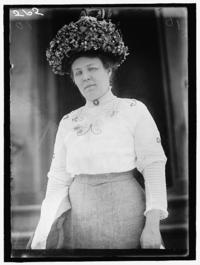 Meta S. Berger. Meta Schlichting Berger (1873 - 1944) was the wife of prominent Milwaukee Socialist Victor Berger 1860 - 1929). She was active in woman suffrage movements and for peace and was a leader among Socialist women. She also served on the Milwaukee School Board and the University of Wisconsin Board of Regents. On March 1, 1931 the Victor L. Berger National Foundation was founded in Washington D.C. Clarence Darrow accepted the position as the foundation's first president. Meta Berger served as one of the Board of Trustees. Library of Congress Prints and Photographs Division, LC-DIG-hec-00171. |
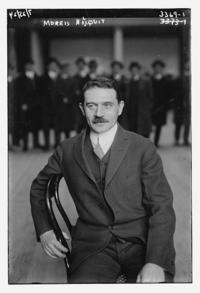 Morris Hillquit. Morris Hillquit (1869 - 1933) was a founder and leader of the Socialist Party of America. He was also a successful labor lawyer in New York City. Although Clarence Darrow fully supported America's involvement in World War I he protested against the suppression of anti-war and socialist literature by the U.S. Postal Service. During World War I Postmaster General Albert Sidney Burleson strongly enforced the Espionage Act by ordering local postmasters to remove and send to him any illegal or suspicious material such as radical publications which included socialist material. Anti-war material was banned from delivery. In July 1917 Darrow, representing the Socialist Party, and several others including Frank P. Walsh, Morris Hillquit, Seymour Stedman and Amos Pinchot went to Washington D.C. to meet with Postmaster Albert Sidney Burleson to discuss the matter. Despite their pleas they were unable to persuade Burleson to remove the ban on what he considered subversive literature. Darrow opposed Hillquit's run for mayor of New York City in 1917 because Hillquit ran as a pacifist. Library of Congress Prints and Photographs Division, LC-DIG-ggbain-18322. |
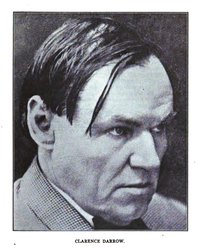 Clarence S. Darrow. Photo of Clarence Darrow that accompanied a short article he wrote in 1914 entitled "The Cost of War" in which he explained his view that the destruction of private property caused by the war would benefit the working class. Published in the International Socialist Review. |
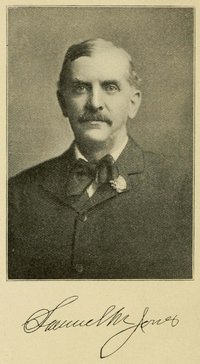 Samuel M. Jones. Samuel M. Jones (1846 - 1904) was a businessman and twice mayor of Toledo, Ohio. Jones was born in Wales and his family immigrated to the United States in 1849. In 1892 Jones moved to Toledo and established a successful business manufacturing tools for the oil industry. He became known as a benevolent employer who refused to pay his workers low wages. He expected employees to work hard and be honest and basically follow the "Golden Rule" and in return he would treat them fairly and pay them enough to support their families. This earned him the name Samuel "Golden Rule" Jones. Jones, a progressive Republican, ran for mayor of Toledo in 1897 and campaigned on the promise to implement the "Golden Rule" philosophy in his administration. Workers supported Jones and he won. After being elected Jones worked to implement progressive reform. He improved the conditions for the laboring class such as an eight-hour work day for city workers, opened free kindergartens, built parks, and reformed city government. Jones believed political party loyalty divided people too much so he encouraged voters and politicians to renounce political parties. He believed that non-partisan politics would unite people. Jones was too progressive for some of the businessmen and wealthier citizens of Toledo and the Republican Party refused to nominate Jones for the mayor in 1899 but he ran anyway. With overwhelming support he won with seventy percent of the vote. Jones died in office on July 12, 1904. Brand Whitlock succeeded Jones and continued his reform efforts. Brand Whitlock wrote a letter to Clarence Darrow in February 1903 in which he stated that he and Jones had frequently discussed Darrow running for mayor of Chicago and that Jones would come to Chicago to campaign for Darrow if he ran. Darrow declined to run to the great disappointment of many in Chicago. Photo from Golden Rule Jones, Mayor of Toledo by Ernest Crosby (1906). |
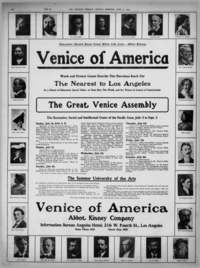 The Great Venice Assembly. In July 1905 Clarence Darrow participated as a speaker in Venice California at the "Venice Assembly" a two month series of educational presentations given by eminent men and women. Earl Rogers, a famous criminal defense lawyer in California who would help defend Darrow in 1912 and 1913 during his bribery trials also participated in the speaking series in Venice. From the Los Angeles Herald, June 25, 1905, Page 12. http://chronicl ingamerica.loc.gov /lccn/sn85042462 /1905-06-25/ed-1/seq-28/ |
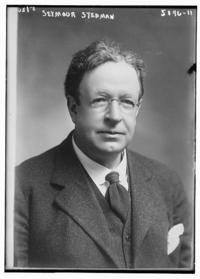 Seymour Stedman. Seymour Stedman (1871 - 1948) was a lawyer and a leader of the Socialist Party of America. In 1920 he was the Vice Presidential candidate of the Socialist Party of America. Eugene V. Debs headed the ticket. In July 1917 Clarence Darrow, and several others including Seymour Stedman, went to Washington D.C. on behalf of the Socialist Party to meet with Postmaster Albert Sidney Burleson to try and convince him to lift his ban on socialist and anti-war literature in the U.S. mail. Library of Congress Prints and Photographs Division, LC-DIG-ggbain-30511. |
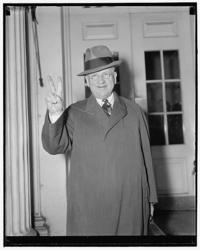 Harold Ickes. Harold Ickes (1874 - 1952) was Secretary of Interior from 1933 to 1946 and he was an important figure in implementing President Roosevelt's New Deal programs. Darrow and Ickes knew each other and they worked together in 1922 to oppose a new Illinois constitution. On November 22, 1922 the People's Protective League was formed and chose Harold Ickes as president. Progressives joined including former Governor Edward Dunne and Darrow. Members of the league actively campaigned against the new constitution by creating and distributing pamphlets and making speeches against its adoption. On December 12, 1922 over a million votes were cast and the new constitution was soundly rejected by a vote of 921,398 to 185,298. Ickes and Darrow were part of a group that urged President Roosevelt to appoint William H. Holly, one Darrow's long time law partners, as a federal judge to the Northern District of Illinois. Holly was appointed in 1933. In this photo, Ickes is leaving the White House after a conference with President Roosevelt. Ickes indicates with his fingers that he has two days left in which to decide whether he will run for Mayor of Chicago on the Liberal Coalition ticket. Library of Congress Prints and Photographs Division, LC-DIG-hec-25551. |
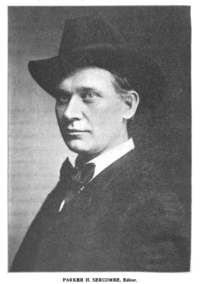 Parker H. Sercombe. In 1905 Clarence Darrow became associated with To-Morrow Magazine which styled itself as a magazine "For People Who Think." The managing editor was Parker H. Sercombe who was rather notorious as a proponent of free love. |
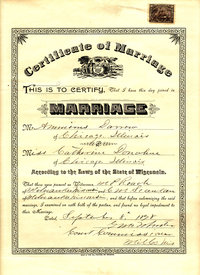 Marriage Certificate of Ammirus Darrow and Katherine Donahue. Ammirus Darrow, Clarence Darrow's father, remarried in 1898. From the Clarence Darrow Papers. |
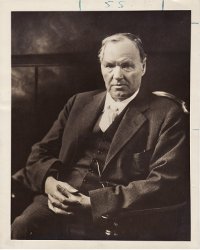 Clarence S. Darrow. |
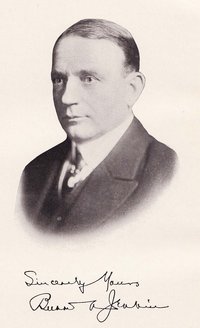 Burris A. Jenkins. Burris Jenkins (1869 - 1945) was a Kansas City minister at the Linwood Boulevard Christian Church in Kansas City, Missouri from 1907 to 1942. Sinclair Lewis interviewed Jenkins and numerous other preachers in Kansas City and observed them during services in preparation for writing his novel Elmer Gantry. Clarence Darrow was friends with both Sinclair Lewis and Burris Jenkins. |
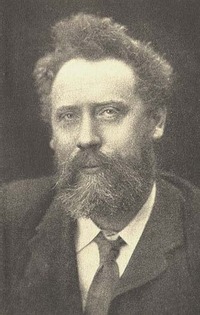 William Ernest Henley. William Ernest Henley (1849 - 1903) was an English poet, critic and editor. At age 12 Henley began to suffer from tuberculosis of the bone and a few years later his left leg had to be amputated. Later his right leg became infected but he resisted suggestions it also had to be amputated. Instead he sought treatment under the pioneering surgeon Joseph Lister and spent about twenty months in the hospital. His most famous work is a short poem "Invictus" which he wrote in 1875 while in a hospital bed. The poem, first published in 1888, expresses resiliency in the face of adversity. It ends with the oft quoted words "I am the master of my fate. I am the captain of my soul." The poem originally did not have a title but it was named "Invictus" when it was later published in The Oxford Book Of English Verse. The title of the 2009 movie about Nelson Mandela and South Africa "Invictus" came from the fact that Mandela kept a copy of the poem during his years in prison. Clarence Darrow scoffed at free will and he used Henley's words to criticize it. In a lecture titled "Facing Life Fearlessly: The Pessimistic Versus The Optimistic View Of Life" before a combined audience of the Poetry Club and the Liberal Club of the University of Chicago Darrow told the audience: "The English poet Henley, in one of his poems, probably expressed this about as well as anybody. It looks to me as if he had a case of the rabies or something like that. But people are fond of repeating it. In his brief poem about Fate he says: I am the master of my fate I am the captain of my soul. A fine captain of his soul; and a fine master of his fate! He wasn't master enough of his fate to get himself born, which is rather important, nor to do much of anything else, except brag about it. Instead of being the captain of his soul, as I have sometimes expressed it, man isn't even a deck-hand on a rudderless ship! He is just floating around and trying to hang on, and hanging on as long as he can. But if it does him any good to repeat Henley, or other nonsense, it is all right to give him a chance to do it, because he hasn't much to look forward to, any way." |
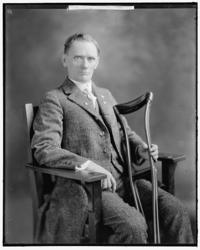 William D. Upshaw. William D. Upshaw (1866 - 1952) served as a U.S. Representative from Georgia in the Democratic Party from 1919 to 1927. Upshaw was one of the most dedicated prohibitionists in the country. In August 1925 Upshaw suggested that the "Wets" (those opposed to prohibition) form a national party and that Dr. Nicholas Murray Butler, president of Columbia University, run as their candidate for President and Clarence Darrow run for Vice President. Upshaw then challenged Murray to a debate. Upshaw was nominated for President by the Prohibition Party in 1932 but lost to Franklin Roosevelt. Upshaw suffered a serious spinal injury at age 18. He spent time in a body cast, in a brace, in a wheelchair, and finally on crutches for all but the last few months of his life. In February 1951 at age 84 he was allegedly cured at the William Branham Healing Service. Library of Congress Prints and Photographs Division, LC-DIG-hec-19352. |
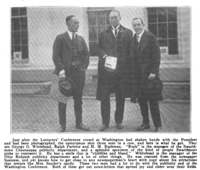 George G. Whitehead. George Whitehead was Clarence Darrow's friend and lecture manager towards the end of his public career. Whitehead first met Darrow in February 1928. |
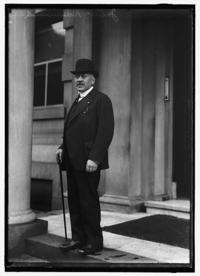 Julius Rosenwald. Julius Rosenwald (1862 - 1932) was President of Sears, Roebuck and Company and a noted philanthropist. A meeting with Booker T. Washington led to the Rosenwald School Building Program to aid poor blacks build schools in the South. This led to the creation in 1917 of the Rosenwald Fund an important charity. For several years Clarence Darrow and Julius Rosenwald served on the Advisory Committee of the NAACP. Library of Congress Prints and Photographs Division, LC-DIG-hec-08365. |
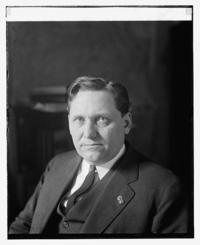 Smith W. Brookhart. Smith Wildman Brookhart (1869 - 1944) served as a U.S. Senator for Iowa from 1922 to 1926 and from 1927 to 1933. Brookhart was a staunch defender of Prohibition. In March 1930 Clarence and Ruby Darrow returned from Europe after a nine month trip abroad. They stopped on the East Coast and Darrow participated in several debates. On March 19 Darrow debated Brookhart on the topic of Prohibition. The debate took place in the Mecca Temple in New York. The audience was overwhelmingly "wet" and Brookhart was subjected to many boos and heckling from the crowd. Earlier in the afternoon Darrow and Brookhart held an informal debate at the Hotel Belmont during a photography session. Library of Congress Prints and Photographs Division, LC-DIG-npcc-10686. |
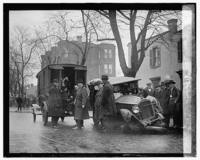 Bootlegger Wrecks after Chase in Washington D.C. "After a thrilling chase through the busiest streets of Washington, ... a couple of bootleggers and their car come to grief at the hands of the Capitol police." Library of Congress, LC-USZ62-96758. |
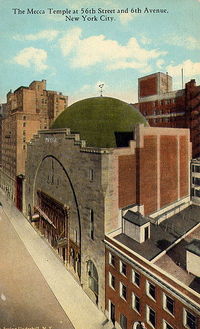 Mecca Temple in New York City. Clarence Darrow participated in several debates in the Mecca Temple. http://en.wikipedia .org/wiki/File:Ccpostcard.jpg |
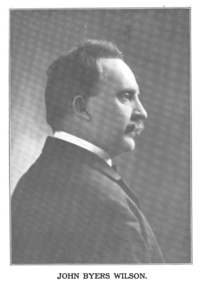 John Byers Wilson. John Byers Wilson (1857 - 1929) was elected president of the American Secular Union in 1899 but resigned a year later to form the American Freethought Federation. These two organizations later combined. Wilson was a close friend of Charles Chilton Moore (1837 - 1906). Moore was an outspoken American atheist, and the editor of the Blue Grass Blade, one of the first newspapers promoting atheism in the United States. Wilson and some friends associated with the Blade formed the National Liberal Party in 1902 and Wilson was elected to be its president. Wilson inscribed a poem to Clarence Darrow titled “In the Fight” that was published in To-Morrow Magazine in 1907 and in Byers’ book of poetry titled Reminiscent Rhymes, and Other Verse published in 1911. Photo from John Byers Wilson, Reminiscent Rhymes, and Other Verse (1911). |
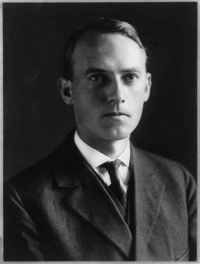 Scott Nearing. Scott Nearing (1883 - 1983) was a radical economist, writer, educator and political activist. On January 7, 1917 Clarence Darrow debated Professor Nearing on the question "Will Democracy Cure the Social Ills of the World?" Darrow argued in the negative. Library of Congress Prints and Photographs Division, LC-USZ62-82851. |
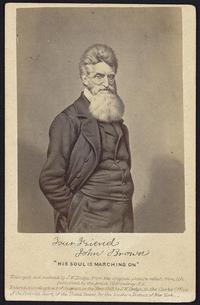 John Brown. Ammirus Darrow's abolitionist beliefs strongly influenced his son Clarence who greatly admired John Brown throughout his life and would later give speeches about Brown. "Your friend John Brown - "his soul is marching on" / enlarged and painted by J.W. Dodge, from the original picture taken from life." Library of Congress Prints and Photographs Division, LC-DIG-ppmsca-07773. |
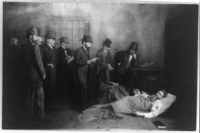 Death Warrant of John Brown. On November 2, 1859 the abolitionist John Brown was convicted of conspiracy, murder, and treason for the raid on Harper's Ferry. He was sentenced to hang and was executed on December 2, 1859. Clarence Darrow admired John Brown and Brown's abolitionist views influenced Darrow to champion the rights of blacks throughout his life. Reproduction of painting copyrighted 1906 by E. Avey. Library of Congress Prints and Photographs Division, LC-USZ62-36581. |
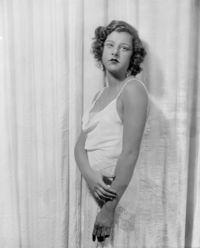 Libby Holman. Libby Holman in a gown designed by Kiviette (1930). Courtesy of The New York Public Library https://digitalcollections .nypl.org/items/510d47dd -e3d7-a3d9-e040-e 00a18064a99 Libby Holman (1904 - 1971) was born in Cincinnati, Ohio, on May 23, 1904, to middle-class parents of German Jewish descent but she and her siblings were not raised in the Jewish faith. In 1923 she became the youngest woman to graduate from the University of Cincinnati. She planned to attend law school but was still too young at age 19. She went to New York to pursue work on Broadway and quickly became very successful. She became famous as a torch singer and for her unconventional lifestyle. She would eventually become good friends with Montgomery Clift. Holman was bisexual and became the lover of Louisa Carpenter, a millionaire member of the du Pont family. Their relationship became the talk of Broadway. In 1931 she married Zachary Smith Reynolds, heir to the R.J. Reynolds tobacco fortune at the time worth about $28 million. On July 5, 1932, Reynolds held a party at his estate near Winston-Salem, North Carolina. Although there are different accounts of exactly what happened some accounts state that Libby told her husband she was pregnant and there was a loud confrontation. Reynolds was shot in the head while in his bedroom and he died the next morning in the hospital. The death was initially declared a suicide. But this was changed to murder and Libby and Ab Walker, Reynolds's best friend, and rumored to be Libby's lover, were charged with the crime. On August 17, 1932 the actor Richard Bennett wrote a letter to his friend Clarence Darrow in which he referred to Libby Holman: "would you refuse a job defending Libby Holman, who is accused of shooting her husband? The question was put to me a week ago, just before your letter arrived. The movie shorts can come later. You remember Libby Holman. She is the girl who came to me after your speech at my party in Sherman Bungalow, and said, 'Dick, that man is my idea of God.'" Libby went into hiding with Louisa Carpenter, and eventually the case was dropped through the influence of the Reynolds family. Libby gave birth on January 9, 1933, to Christopher "Topper" Reynolds, who became a new heir to the R. J. Reynolds tobacco fortune and the birth was a huge news story. In 1945 her second husband, Actor Ralph Holmes, died from an overdose of sleeping pills. As she grew older Libby became devoted to civil rights, peace, and disarmament activities. Her 18 years old son Christopher "Topper" died on August 7, 1950 along with a friend while trying to climb Mount Whitney, the highest peak in the lower 48 states. After a bitter estate fight Libby was reportedly awarded $6,600,000 from her son's share of the Reynolds estate. In Topper's memory, Holman founded the Christopher Reynolds Foundation in 1952. The foundation financed her friend Martin Luther King, Jr.'s visit to India to meet Mahatma Gandhi in 1959. The foundation is still in existence. |
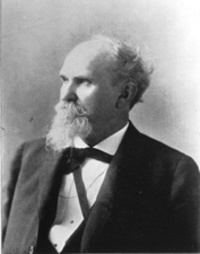 James Kimbrough Jones. James Kimbrough Jones (1839 - 1908) was born in Marshall County, Mississippi and moved to Arkansas shortly before the Civil War. During the war he served in the Confederate Army. He later served as a United States Senator from Arkansas from 1885 to 1903. He was the chairman of the Democratic National Committee in the 1896 and 1900 campaigns. After he lost his reelection bid for the senate in 1903 he resumed private practice in Washington, D.C. as an attorney for oil developers in Oklahoma until his death in 1908. Clarence Darrow knew Jones and they corresponded by letter. Collection of U.S. House of Representatives. |
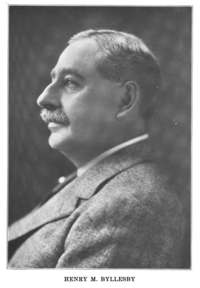 Henry Marison Byllesby. Henry Marison Byllesby (1859 - 1924) was one of the most prominent electrical engineers of his time. Around 1881, after Byllesby earned an engineering degree, he was hired by Thomas Edison to help build an electrical station in Manhattan. In 1885 he was hired by George Westinghouse to manage his electrical company. Byllesby moved to St. Paul, Minnesota in 1891 to run an electrical company. He formed a power company in 1909 and changed the name of the company to Northern States Power in 1916. The company supplied power throughout Minnesota. He formed H.M. Byllesby & Co. a Chicago-based conglomerate that owned steamships, streetcars and utility companies across the United States. He was also an officer and director of many public gas and electric utility companies. Soon after Germany started World War I, Byllesby became a prominent supporter of the Allies. Beginning in April 1917 he began working full-time as the Chairman of the Executive Committee of the Chicago Branch of the National Security League. This was a public service organization founded in 1914 to lobby for increased and improved preparation for America's defense against enemies at home and abroad. Byllesby was primarily responsible for the inauguration of a patriotic speaking campaign which opened in Minneapolis in September, 1917 with Samuel Gompers and Clarence Darrow as principal speakers. In 1917 Byllesby accepted a commission as a major and served in the Signal Corps and was later promoted to lieutenant-colonel. He also served in London as the purchasing agent for the American Expeditionary Force. Clarence Darrow knew Byllesby and served with him on the Chicago Branch of the National Security League. Darrow also conferred with Byllesby about investments in gas utilities. Photo from volume 4 of Josiah Seymour Currey, Chicago: Its History and Its Builders (1918). |
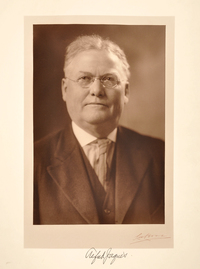 Alfred Jaques, 1857 - 1937. Alfred Jaques (sometimes spelled Jacques) who was born in Geneseo, Illinois. After being admitted to the bar in Illinois in 1882, he moved to Duluth, Minnesota where he practiced law, later became a municipal judge and for a time was the director of the Duluth Bar Library. Jaques later moved to St. Paul. He served as the U.S. District Attorney for the District of Minnesota from 1914 to 1922. In the summer of 1917 Jaques arrested over 200 Finnish members of the Industrial Workers of the World (I.W.W.) in the Iron Range for failing to register for the draft and for preparing to go on strike instead of working in the mines. In a report to the Attorney General Jaques stated it was a good idea to keep these IWW aliens so busy defending prosecutions for failure to register that they would not have time to plot against the industrial interests of Northern Minnesota. Jaques also participated in politics, unsuccessfully running for Congress in 1910 and Governor in 1926. He was a delegate to the Democratic National Convention in 1912. In a letter he wrote to his son Paul in 1927, Clarence Darrow said that he was friends with Jaques for 30 years. |
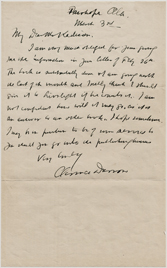 Letter by Darrow to Alexander Kadison, March 3 [1927]. Darrow wrote this letter to Alexander Kadison regarding his book, The Prohibition Mania: A Reply to Professor Irving Fisher and Others, co-authored by Victor S. Yarros and published by Boni and Liveright in 1927. Kadison had written Through Agnostic Spectacles (1919), on a theme Darrow had strong sympathy for. |
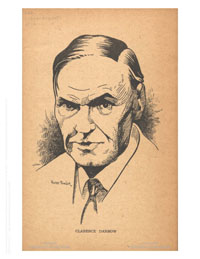 My 11 Years with Clarence Darrow. Victor S. Yarros (1865 – 1956) was a Russian born anarchist, journalist, and lawyer. He emigrated to the United States in the early 1880s and later married Rachelle Slobodinsky Yarros (1869 – 1946) who had also emigrated from Russia. She became a physician, a supporter of birth control, the social hygiene movement, and lived at Hull House for twenty years. Victor Yarros worked part-time in a law firm with Clarence Darrow from 1914 to 1925. He later wrote a pamphlet titled My 11 Years with Clarence Darrow published in 1950 by Haldeman-Julius. |
 Mary Darrow Olson (1852-1909). Clarence Darrow's oldest sister. She married Olaf G. Olson. Bio from: Educational History of Illinois: Growth and Progress in Educational Affairs of the State from the Earliest Day to the Present, with Portraits and Biographies (1912). |

